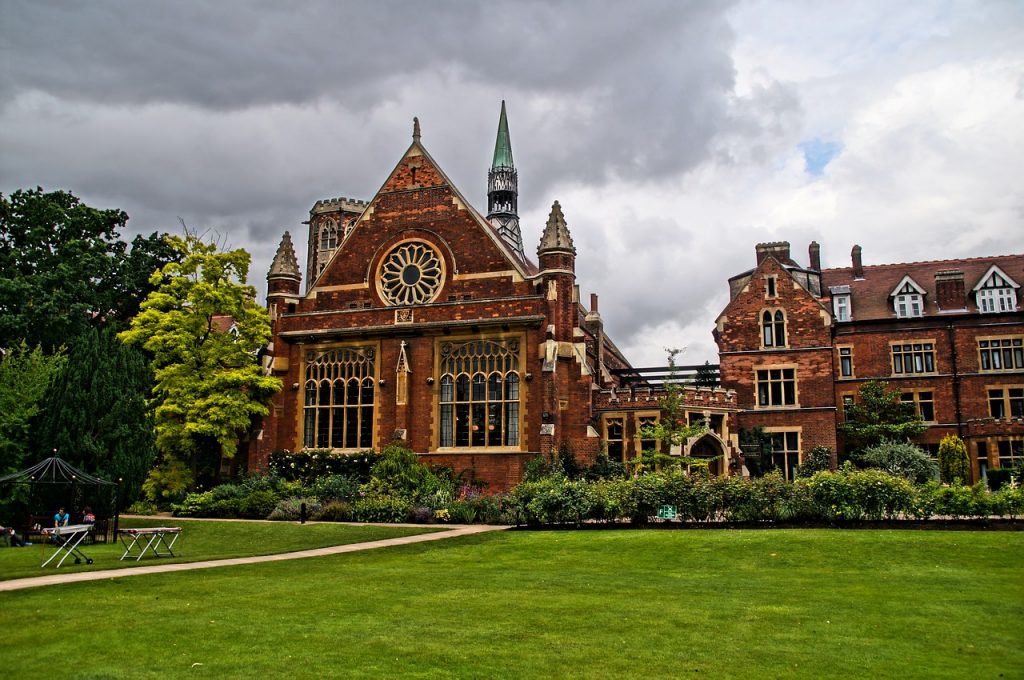The Jefferson-Madison Debates: Socialism in Our Time
January 2nd, 2019 // 8:43 pm @ Oliver DeMille
The Mantra of Today’s Media and Universities
“These were the pleasantest days of Sam’s life, these days in the woods, far from everywhere—no automobiles, no roads, no people, no noise, no school, no homework, no problems, except the problem of getting lost. And, of course, the problem of what to be when he grew up. Every boy has that problem.”
—Sam Beaver[i]
“And it was here that I learned the value
of economicness—which means saving.”
—Tucker Mouse[ii]
“…peace in our time.”[iii]
—Neville Chamberlain, 1938
I. The Two Drives: Strong vs. Weak
A century ago, and two centuries ago for that matter, the typical American judged himself according to a code of individual strength, in terms that might seem somewhat barbaric in current society. Today most people try to be more socialized; some would say more socially “acceptable”. Compliance is now largely considered a good thing—something our individualized American from the early 1900s would find objectionable.
The inner reality of many moderns is even more telling. A lot of people now judge themself not by strength, character, or individualistic achievement, but rather the exact opposite—how well they fit in with others. How popular they are. How closely they match the crowd. We are, by and large, supremely socialized now. Socialization has worked for at least two, going on three, generations.
Anyone not quite civilized in this respect, anyone who is still “rough around the edges,” or individualistic, doesn’t fit the mold very well. This is widely considered a serious fault. If you doubt how strong this hold is on most modern families and parents, try the following simple experiment: pull your children out of school and announce that you plan to homeschool, then keep track of how many people ask you “What about their academics?” versus “But what about their socialization?” The first list will likely be short, or non-existent, the second will be long. Indeed, without quite realizing it, our society has adopted socialization as arguably the highest purpose of our educational system. And even of parenting. Or, alternatively, try an even more challenging project: quit your job and start a business. See which people you know think you are courageous and strong for striking out on your own, versus those who consider your choice rash, reckless, even “crazy”.
These two drives—the one to stand apart, to excel as a unique individual, to be one’s true self, versus the other, to fit in, to be like everyone else, to be popular with peers, to be a “peer” at all—have long been at odds. Ironically, despite current popular views, history shows that the drive to stand out is the natural companion of progress, while a widespread drive to feel popular always accompanies societal decline.[iv]
Make no mistake, actual progress in a society is nearly always led by people making choices that don’t “fit in”, individuals who are hungry, driven, enterprising. Positive change in the world is an uphill slugfest, a challenging epic of work, overcoming roadblocks, and more work. It is seldom comfortable. Where the people are comfortable—in their job, career, or community—little leadership is at play. Leadership breeds discomfort, and thereby change.
If you are comfortable, you probably aren’t leading. (Nor are you, for that matter, likely to be experiencing effective leadership from anyone else.) Decline, on the other hand, is typically mired in comfort, until a major crisis or setback arises, when chaos and terror set in. But the path to such events is usually filled with what past generations could only describe as weak, though one still deals with the stresses of trying to meet the approval of others, punctuated with as much free-time entertainment as possible.
Philosophers and scholars have long been fascinated with the idea of “socialization”. It is at times the supreme goal of societies (“is the society savage or advanced?”, “let’s make sure they get socialized”), and on the other hand it typically coincides with growing weakness, mediocrity, sloth. Softness. Whining. Calls for more government help to get by. Ultimately, decline. For Aristotle, this division began with the difference between the community (a group of families, each choosing and acting as individual units, while generally coordinating and working together for common goals—always voluntarily) and the city (the “civis”, root of the word “civilization”, made up of many more people than a community, so many in fact that the most “efficient” way to govern them was for a few elites to rule things from the top down; for the few to tell the many how to live). This has ever been the great divide: bottom-up self rule by individuals,families, and communities, versus top-down rule by a group of elites, usually through government.
The first naturally adopts individualistic goals and mannerisms; the other flourishes as people put aside individualism and desire mainly to fit in. Elizabeth Bennet versus Caroline Bingley, to put a fine point on it. Colonel Brandon vs. Willoughby. It is the Ayn Rand hero versus today’s “acceptable” modern man or woman. John Adams considered this the great battle of humanity, and the choice each of us needs to make in life: either to serve, improve, and progress, or, alternatively, to spend our lives trying to impress others.[v]
The Talmudic tradition traces the history of this division to Abraham—the traveler and nomad, hearty and robust enough to survive in the harsh conditions of the desert and rock-laden Near Eastern mountains, protecting his herds, leading his soldiers as they fought bandits and avoided the control of petty princes in every city. The opposite of Abraham was Lot, and what happened to his once strong nomadic family when they settled into the city life characteristic of Sodom and Gomorrah. Note that his very name, Lot, has become a word meaning group, collective, batch, or bunch. Today’s synonyms of “lot” also include “assembly,” “throng”, “horde”, “swarm” and “mob”. The “lot” is socialized, and where this is true, socialism is usually on the rise.
Alternatively, the Teddy Roosevelt style individualists mentioned above, both men and women, were driven by progress. Specifically, the hard work of progress. For today’s “socialized” seeker of ease, in contrast, comfort rules. Safety. Being cared for. No wonder socialism is gaining popularity. Not surprisingly, under socialism, the biggest goal of youth education is socialization. Learning to follow the orders of superiors and officials. Showing up on time, getting in line, and giving rote answers—well memorized, and well groomed. Socialized. Manicured. Compliant. “Good” students and “good” employees in this regime obey their superiors, focus on scoring well on state-designed tests, and repeat. Whether in school, factory, or corporate high-rise, in the airport or online, the mold is cast—socialization all grown up.
II. Socialism’s Center
Today the biggest catalyst and supporter of spreading socialism is none other than higher education—the colleges and universities, aided and abetted by much of the media. This is ironic, given that universities and independent media were first invented to foment free thinking, individualistic pushback against aristocratic rule, to lead rebellion against elite domination and the stifling social pressure to always please the elites. To speak truth to power. The idea was that ideas, thinking, and knowledge would empower people against elite rule of any kind.
Nearly all of today’s campuses, in contrast, are both the incubators and lifeblood of the Socialist movement. Socialization is the prime rule. Combine this with a world where most parents believe that “each child must go to college”, and we have the recipe for a major societal revolution in the decades just ahead. Indeed, it is already happening.
As I wrote recently, while addressing another topic:
“On the political front, in the post Bernie Sanders era, many Millennials [born between 1984 and 2001] support government-mandated free college, free housing, a monthly wage for everyone whether or not they have a job, and the appeal of ‘socialism.’ Many even like the word or label of ‘socialism’, with over half of Millennials self-identifying as ‘socialist’.[vi]
“But, ironically, they have little appetite for the ‘struggle of the working class to create a socialist society.’ [vii] That’s too much work. And they certainly aren’t looking for ‘the long revolution’ to bring about socialism.[viii] They just want socialist programs handed to them by big government, without any personal struggle, sacrifice, or effort.[ix] Many Millennials seem to feel they ‘deserve’ such programs, without doing anything to earn them.”[x]
Comfort. Being taken care of. Staying in line. Not the struggle to accomplish or build. In a word: socialization.
This is largely the work of modern education, from elementary and high school to the colleges and universities, followed by the continuing adult “education” of mainstream media. Austrian economist Ludwig von Mises warned many years ago that this exact situation was coming.
As he put it: “The typical graduate of colleges and high schools very soon forgets most of the things he has learned. But there is one piece of indoctrination which makes a lasting impression on his mind, viz., the dogma of the irreversibility of the trend toward all-round planning and regimentation. He does not doubt the thesis that mankind will never return to capitalism, the dismal system of an age gone forever, and that the ‘wave of the future’ carries us toward the promised land of [socialism]. If he had any doubts, what he reads in newspapers and what he hears from the politicians would dispel them…. Thus the average man is predisposed in favor of socialism.”[xi]
Mises warned that college too often changes students, convinces them, frequently against the teachings of their parents and childhood communities, that experts are always right, or almost always right, and that government experts, those licensed or approved by the government, are especially right. A result of college is often the alteration of a young individualist who questions things, especially authority, to a socialized person who generally accepts almost everything an expert says—particularly if the expert leads with his/her prestigious or official credentials, or both.
Another result is the all-to-frequent habit of believing most of whatever is mainstream, without any independent, personal research on the topic. A kind of “educated” mythology has become part of our modern reality—created by formative years packed with a plethora of hours sitting passively in class, taking notes of what experts say, then memorizing and being tested, graded, and ranked on the basis of how well one agrees with the experts. Few individuals get out unscathed.
This weakening of the habit of independent thinking and speaking truth to power is one of the typical outcomes for many who finish college, Mises warned. For example: “A few years ago a House of Representatives subcommittee on publicity and propaganda in the executive departments, underthe chairmanship of Representative Forest A. Harness, investigated federal propaganda operations. On one occasion the committee had as a witness a government-employed doctor. When asked if his public speeches throughout the country presented both sides of the discussion touching compulsory national health insurance, this witness answered: ‘I don’t know what you mean by both sides.’”[xii]
Mises was not impressed. “This naïve answer” he noted, “throws light on the state of mind of people who proudly call themselves progressive intellectuals. They simply do not imagine that any argument could be advanced against the various schemes they are suggesting. As they see it, everybody, without asking questions, must support every project aiming at more and more government control of all aspects of the citizen’s life and conduct. They never try to refute the objections raised against their doctrines.”[xiii] They seldom show the other side, even in the halls of higher education. They prefer a populace, including the college-educated masses, who will listen, believe, and go about their work without much questioning.
“Many citizens hold educational institutions responsible for the spread of this bigotry”, Mises argued.[xiv] “They sharply criticize the way in which economics, philosophy, sociology, history and political science are taught at most American universities and colleges. They blame many teachers for indoctrinating their students with the ideas of all-round planning, socialism…. Some of those attacked try to deny any responsibility. Others, realizing the futility of this mode of defense, cry out about ‘persecution’ and infringement of ‘academic freedom.’”[xv]
Whether by denial or deflection, the universities usually manage to change the subject without ever answering the question: Why, in our time, do “liberal professors outnumber conservatives nearly 12-1”?[xvi] Why is only one side presented? Why aren’t all sides allowed the full light of day, and the students taught to compare, contrast, weigh, analyze, and work for their own conclusions? In short, why aren’t they taught how to think? Are these actually schools, or are they more like places of indoctrination?
Why do “39% of [the top] colleges have 0 Republican professors”?[xvii] This is the opposite of diversity, yet instead of considering this situation a glaring weakness, many schools seem proud of their status, of “drowning in blue”[xviii] and “Telling students what to think…not how to think”.[xix] As a researcher for the National Association of Scholars summarized a study of college faculties in 2016, “…78.2 percent of the academic departments in my sample [“51 of the 60 top-ranked liberal arts colleges”/universities] have either zero Republicans—or so few as to make no difference.”[xx]
If only those on the Left are allowed to teach our college students, who shows young people the other sides? Again, who teaches the students (and future or current voters) how to think, to consider different views and arguments, ponder and research, and develop their own conclusions? Who prepares them to think independently when they read or watch the news? Are they expected to treat the media like so many professors—and just accept what they are told? And why would any real teacher train students to “just accept and obey” in the first place, rather than consider, contrast, verify, and think?
Mises already provided the answer: “Yet what is unsatisfactory with the present-day academic conditions—not only in this country but in most foreign nations—is not the fact that many teachers are blindly committed to Veblenian,[xxi]Marxian and Keynesian fallacies, and try to convince their students that no tenable objections can be raised against what they call progressive policies. The mischief is rather to be seen in the fact that the statements of these teachers are not challenged by any criticism in the academic sphere. The pseudo-liberals monopolize the teaching jobs at many universities. Only men who agree with them are appointed as teachers and instructors of the social sciences, and only textbooks supporting their ideas are used. The essential question is not how to get rid of inept teachers and poor textbooks. It is how to give the students an opportunity to hear something about the ideas of economists rejecting the tenets of the interventionists, inflationists, Socialists….”[xxii] This is a very real dilemma, and the numbers are worse today than when Mises pointed them out.
III. What is Free Enterprise?
When Mises refers to “capitalism,” and “free enterprise,” he means something specific. What is it? The fact that so few people with long years of high school and college education, including graduate studies, can easily answer this question puts the quality of our educational systems in doubt. Here is the answer, in Mises’ typically Socratic way of asking questions:
“Do the American voters know that the unprecedented improvement in their standard of living that the last hundred years brought was the result of the steady rise in the per-head quota of capital invested?”[xxiii]
Stop here for a moment and be sure you clearly understand what he is saying. The American Dream, the rising standard of living that has become part of what most Americans consider a normal experience, at least until 2008, was based on freedom and entrepreneurship, but the key thing that makes it work is when freedom and entrepreneurship combine to increase the per-person amount of invested capital in the nation. When this level of available and utilized capital per person rises, the nation gets more prosperous. If it were ever to fall, most people would get much poorer. Quickly. It fell during the Great Depression, and during the crash of 2008-2011. Fortunately, it eventually bounced back—but only because changes were made to government policy that rolled back regulation and rebooted the levels of per-person capital invested in the economy. Mises’ next sentence continues this point:
“Do they realize that every measure leading to capital decumulation jeopardizes their prosperity? Are they aware of the conditions that make their wage rates tower above those of other countries?”[xxiv]
“What is needed is to make the importance of these problems understood by everybody. No party platform is to be considered as satisfactory that does not contain the following point: As the prosperity of the nation and height of wage rates depend on a continual increase in the capital invested in its plants, mines and farms, it is one of the foremost tasks of good government to remove all obstacles that hinder the accumulation and investment of new capital.”[xxv]
This is the key point, in a nutshell. If there is a continual increase in available capital,[xxvi] and effective entrepreneurs to employ it widely,[xxvii] the economy will grow, and if there is freedom, everyone will have the opportunity to benefit from the continual increase in available capital—in fact, their hard work and/or entrepreneurial success in such a system will further increase capital to the benefit of others. This leads to the growth and spread of wealth among the regular people. But when there is not a continual increase in capital along with freedom, then socialism—or some other form of top-down elite control—is at play, and the regular people get poorer and less powerful.
Again, few Americans today know this simple definition. Even fewer can immediately articulate it as the central economic reality of a growing versus declining economy. This is a failure at all levels of education, and an even more shameful reality in a society that spends so much time and money on higher education and media.
Those who claim to be socialists, or progressives or liberals, miss this point when they argue against profit. Mises put it succinctly: “The progressives consider profits as objectionable. The very existence of profits is in their eyes a proof that wage rates could be raised [by government force] without harm to anybody…”[xxviii]
But they “speak of profit without dealing with its corollary, loss. Profit and loss are the instruments by means of which the consumers keep a tight rein on all entrepreneurial activities. A profitable enterprise tends to expand, an unprofitable one tends to shrink.
“The elimination of profit renders production rigid and abolishes the consumers’ sovereignty. This will happen not because the enterprisers are mean and greedy, and lack these monkish virtues of self-sacrifice which the planners ascribe to all other people. In the absence of profits the entrepreneurs would not learn what the wants of the consumers are, and if they were to guess, they would not have the means to adjust and to expand their plants accordingly.”[xxix]
He continues: “The market system makes all men in their capacity as producers responsible to the consumer. This dependence is direct with entrepreneurs, capitalists, farmers, and professional men, and indirect with people working for salaries and wages….
“The economic system of the division of labor, in which everybody provides for his own needs by serving other people, cannot operate if there is no factor adjusting the producers’ efforts to the wishes of those for whom they produce. If the market is not allowed to steer the whole economic apparatus [free enterprise], the government must do it [socialism].”[xxx]
IV. What is Socialism?
Here Mises addresses another very important question: What is “socialism”? As with “free enterprise”, few people today can give an immediate, clear, and accurate answer. Mises makes it simple:
“Under socialism, production is entirely directed by the orders of the central board of production management [whatever it is called in a specific government, such as The Department of…X]. The whole nation is an ‘industrial army’…and each citizen is bound to obey his superior’s orders.”[xxxi] Note that these superiors are government officials.
Mises: “In the free economy, no production czar tells a man what he should do. Everyone acts for himself.”[xxxii] The word for this system, where no “czar tells a man what to do”, is “freedom”, or “free enterprise”. The word for “each citizen is bound to obey his superior’s orders” is not freedom. It is socialism, or some other type of authoritarian rule. Which begs the question: Why do a number of people who wantmore freedom for the regular people say they like socialism? Answer: They don’t understand what socialism actually is or does.
Free enterprise works because the consumers decide what the entrepreneurs and producers make and distribute. Whatever they purchase influences what businesses will make and offer in the future.[xxxiii] This gives more power to the regular people than any other social system in history. Nations that apply this model become wealthy, in a widespread way that gives more opportunity to almost everyone, and people from other nations flock to immigrate and partake in the numerous benefits of free enterprise. Note that very few people are flocking to leave free enterprise nations and immigrate to socialist countries.
Why then do socialists try to stop entrepreneurs and producers from delivering what the people want? In Mises’ words: “…the socialist writers are at least clear-sighted enough to see that simply to paralyze the market system results in nothing but chaos. When they favor such acts of sabotage and destruction, they do so because they believe that the chaos brought about will pave the way for socialism.”[xxxiv] This is precisely what much of modern media and academia do today.
“But those who pretend that they want to preserve freedom, while they are eager to fix prices, wage rates, and interest rates at a level different from that of the market, delude themselves. There is no other alternative to totalitarian slavery than liberty.
“There is no other planning for freedom and general welfare than to let the market system work. There is no other means to attain full employment, rising real wage rates, and a high standard of living for the common man than private initiative and free enterprise.”[xxxv]
V. Why Is Socialism Sometimes Popular?
Why doesn’t every high school and college graduate clearly understand this? If we put roadblocks in the way of continually increased capital, we only hurt ourselves, and our families. The biggest such roadblocks are government regulations and controls, and the level of taxes necessary to fund a government that is big enough to continually increase such government regulations. The reality is clear and simple: the regular people prosper in a free society where there is a continual increase in capital and opportunity, and the regular people suffer and society declines in a nation where there is instead a continual growth in government regulations.
“Then why isn’t everyone in our society today getting wealthy?” the critics of free enterprise will ask. Answer: Precisely because we are no longer a truly free enterprise system. We now apply more socialism than not. Not as much as some nations, it is true, which is a major reason why immigrants still want to come here, and not there. But we apply much more socialism than is good for true economic success for people at all levels of society—as a result, those at the middle and bottom end of the economy struggle much more than they would in a truly free enterprise system.
Also, our government, as it increases socialist regulation and policy, decade after decade, makes the spread of wealth to the regular people even more difficult. That’s what socialism does. This directly leads to more force-based government, because people are told that we are living in a free system but they don’t experience the benefits of vigorous economic opportunity. When they voice their frustration, too many politicians, professors, and so-called journalists answer that more government intervention in the economy would help everyone. The opposite is the actual truth, but too few people have the educational understanding to realize the lie—especially since it comes from sources they learned in schools to trust, namely academia, media, and Washington.
Mises put it clearly: “Tyranny is the political corollary of socialism, as representative government is the political corollary of the market economy.”[xxxvi] Socialism always ends up with a small, elite ruling class and a nation full of people with poor or stagnant finances. So why would anyone consider socialism the best approach? Short answer: the socialists lie. Led by many of those in academia, media, and government.
A basic reading of history shows the wisdom of Mises’ words: “As the harbingers of socialism tell us again and again, socialism will not only make all people rich, but will also bring perfect freedom to everybody. The transition to socialism, declares Frederick Engels, the friend and collaborator of Marx, is the leap of mankind from the realm of necessity into the realm of freedom. Under capitalism, say the Communists, there is bondage for the immense majority; in the Soviet Union alone there is genuine liberty for all.”[xxxvii]
These promises are all lies, Mises points out. How anyone with a basic knowledge of history can believe such an argument is almost inconceivable. But if the experts push it, and there are none to show another side, only a lot of personal reading and deep thinking is likely to expose the truth.
Instead, in too many cases, in most cases in fact, the message many college graduates remember is something like the following, as described by Mises: “The tycoons are too powerful, too rich and too big. They abuse their power for their own enrichment. They are irresponsible tyrants. Bigness of an enterprise is in itself an evil. There is no reason why some men should own millions while others are poor. The wealth of the few is the cause of the poverty of the masses.”[xxxviii] And, the conclusion: bigger government is the answer, and socialism is the solution.
All of these messages are pure mis-education. They are, however, subtle, and they have proven quite effective in convincing people, built as they are on layers of experts, credentials, and government certifications—and generations of youth trained to believe these sources without really questioning them. The more conveyor-belt schooling a person has, the more he/she has been encouraged to accept the words of experts and dismiss the words of anyone who doesn’t agree with the “accepted” “wisdom”. A few see through this, even with a great deal of formal education; many people don’t.
Mises continued: “Each word of these passionate denunciations [above] is false…. It is precisely the necessity of making profits and avoiding losses that gives to the consumers a firm hold over the entrepreneurs and forces them to comply with the wishes of the people.”[xxxix] This assumes, of course, that the government equally and impartially protects the freedoms and rights of all, big and small. Such an arrangement is called free enterprise. Sadly, socialist and progressive policies nearly always do the opposite.
In truth, it is through lack of real education that the nation falters. Those who don’t individually study history, and search out what really happens when socialism—in any form—is applied, are more likely to consider socialism a good idea. Socialism and widespread ignorance always travel hand in hand. In the long term, socialism has been a disaster for the regular people everywhere it was implemented.
Note the following pattern in history: Socialists win when they convince the people that socialism will make everyone more equally prosperous, and then the nation adopts socialism and the regular people get poorer and poorer. Any leader who actually deregulates the economy and unleashes free enterprise in a nation releases a huge economic boom; the socialists respond to such evidence by changing tactics, ignoring the economy, and loudly attacking the leader’s personality or background. When they win, meaning that another leader is put into office, one who rekindles socialist regulations and controls, the economy slows and the regular people get poorer. The socialist promises of prosperity for everyone never actually come to pass. Again, history is clear on this reality.[xl] But to know this, reading is needed.
Those who do such diligent reading of history usually find the truth. For example, unless a young person has read a book or two by Solzhenitsyn about socialism, and at least one by Bastiat, he or she is uneducated on the topic. Period. Read three books by Solzhenitsyn, and a person is ready to actually begin a real discussion about socialism. Supporters of socialism typically respond to this by trying to differentiate between socialism and communism, arguing that while communism may be bad, socialism is much better. But this is a distraction; the pattern above is common to both.
In Marxism, to be clear, socialism and communism have the same goals, just a different way of getting there. A third variant of socialism, social democracy, which is applied in many democratic nations, particularly in the West, shares the same goals as communism and socialism. Again, the methods vary, but the target is the same. Most importantly, the long-term trajectory of the regular people is the same under all these types of socialism, or similar enough to be considered the same by any honest observer. They get poorer.
This pattern is the same followed by socialists throughout history, and around the world. As noted above, sometimes they call themselves socialists, other times communists, and still other times social democrats, democratic socialists, progressives or liberals. Again, the pattern is the same. This pattern is not, of course, the idealistic theory of socialism, as many socialists like to point out, but it is what actually happens almost every time socialism and its variants are implemented. The exceptions are found only in the short term; in the long term all socialist regimes follow this pattern. In other words, this is the reality of socialism—over and over and over, regardless of the theory.
Mises concludes the point: “Men must choose between capitalism and socialism. They cannot avoid this dilemma by resorting to a capitalist system without entrepreneurial profit. Every step toward the elimination of profit is progress on the way toward social disintegration.”[xli]
VI. The Trifecta: Socialization, Sociality, Socialism
Moreover, as too few people understand, only when capital is plentifully available and the regular people are free to entrepreneur such capital into prosperity does a nation flourish economically. This doesn’t just happen automatically, despite the fact that many “educated” people have come to believe it does.
Mises: “Profits are never normal…it is not the capital employed that creates profits and losses. Capital does not ‘beget’ profit as Marx thought. The capital goods as such are dead things that in themselves do not accomplish anything. If they are utilized according to a good idea, profit results. If they are utilized according to a mistaken idea, no profit or losses result. It is the entrepreneurial decision that creates either profit or loss. It is mental acts, the mind of the entrepreneur, from which profits ultimately originate.”[xlii]
“In choosing between capitalism and socialism people are implicitly choosing between all the social institutions which are the necessary accompaniment of each of these systems…. If control of production is shifted from the hands of entrepreneurs, daily anew elected by [the choices] of the consumers, into the hands of [government officials], neither representative government nor any civil liberties can survive.”[xliii]
Of course, in the current environment, the quick skim of history that passes for “education” in too many schools, including many colleges and universities, doesn’t prepare us very well. We must read deeply. Thus the idea that free enterprise is the lifeblood of freedom, and that socialism is just another means of elite domination, is a contrarian viewpoint today. It also, however, happens to be true.
This dichotomy has nearly always been with us, to be accurate. Courtiers in Egypt and later Rome shook their heads at the independence-oriented choices of the Israelites, medieval aristocrats scoffed at the same freedom-loving traits in entrepreneurial merchants, and the British wondered why the American colonists would adopt such “rebellious” and “unsociable” views in the 1770s. Why not just pay the tea tax and get along with everyone? Why rock the boat? Why put limits on government? What kind of people are these Americans, anyway, with their insistence on principles over obedience, and independence over sociality?
Yet the Americans called such “sociality” what it really was—submission to the rule of elites. In our day the same independent approach is still frowned upon by elites, and other people who have been convinced or conditioned to spend their lives trying to impress elites and aspire to elitist cultural standards and values. Why try to impress and follow elites? Because: too much of modern “education” presents it as the classy, normal, tasteful, acceptable thing to do. The socialists have done their work.
Spreading this kind of socialization in our nation was time-consuming and difficult, but now socialization has become the norm—in action, if not in name.
Sad.
Washington and Jefferson didn’t approve of trying to impress such “Tory” thinking in their time, and I highly doubt they would approve of trying to impress elites today. We should follow the Jeffersonian wisdom on this, not to get along, or to fit in, and not to impress elites, but because freedom is worth taking a stand. It’s the right thing to do.
VII. Will Socialism Succeed or Fail in Our Time?
And let’s be clear: socialism is absolutely the opposite of freedom. The more socialism spreads in a society, the more the regular people struggle to make ends meet, and the more their standard of living decreases.The longer socialist policies endure, the worse it gets, and the less power the regular people have to improve their situation. This is the repeated legacy of socialism. In the communist application of socialism it happens quickly, while it occurs more slowly under social democracy. But it happens, eventually, in all forms of socialism—at least, it always has.
Again, some will argue that this occurs because societies fail to implement the “real”, or “pure” form of socialism. “If only we apply socialism the right way this time,” they argue, “things will work out differently.” But nobody has done it the “right” way in a lasting system. Instead, over and over, those trying to implement socialism have repeated the same predictable mistakes. Given this reality, why would anyone want to repeat such a consistent error of history by adopting any level of socialism?
Ironically, I think many Millennials who say they are “socialists” actually mean that they don’t like the current system. Since they are told in school, inaccurately, that in the current system we are already following a free enterprise approach, that this is the source of their generation’s problems, and that socialism is a different model that brings more prosperity to the regular people, they naturally cheer for socialism. The reality that every socialist-promoted “fact” in the last sentence is a lie can only become part of the dialogue if Americans take the time to deeply learn the truth, ponder the options in detail, think critically, and choose wisely. Most of academia and the media, despite promises to the contrary, actually act against this approach.
Socialism, by whatever name, is now the mantra of most schools, universities and media outlets. The future of our nation literally depends on effectively overcoming this reality. This is going to call for people who stand up, stand out, and reject the orthodoxy of trying to impress elites and elite-promoted values.
Notice #1: Efforts to impress the elites end up allowing more socialism and hurting us all, including our economic opportunities, our freedoms, our families, and our future.
Notice #2: The elites won’t be impressed anyway. The only thing that actually impresses them (and simultaneously frustrates them) is when the regular people stand up and implement real freedom. Free enterprise does this; socialism does the opposite.
Notice #3: Every step toward further socialism decreases the power and long-term prosperity of the regular people, and gives more power to a small class of elite rulers. The socialists say the opposite, but they have been wrong every time socialism was implemented in history. It’s time to reject their lies, even those that are well-intentioned.
Notice #4: Unless Millennials, and other generations as well, actually learn what socialism does to the regular people (not what it claims, but what it actually does to them), they are on track to repeat this tragic mistake of history.
Notice #5: Whenever any politician or party promises anything for free, it is being subsidized by elites, nearly always the very elite corporations and corporate interests that socialists claim to despise. Why do elites subsidize free things (college tuition, healthcare, housing, raised minimum wage, etc.)? Answer: Because they find ways to pass this expense on to the regular people, and, also, this approach gives them the power of masters over the people they subsidize (slaves, or slaves in training). That’s actual socialism.
In free enterprise, private property ownership and entrepreneurship is the basis of freedom, prosperity, security and progress. According to socialism, in contrast, private property ownership and entrepreneurship is the “root of all degeneration in society.”[xliv]
A philosophy that believes private property is evil is going to take it away from the regular people—making them poor. That’s socialism. Pure and simple.
And then, as time passes, it will make them increasingly poor. And since a lot of people like material things (like land, food, shelter, clothing, etc.), and want them, a system dedicated to taking these things away from most people is going to force, hurt, kill, torture—whatever it takes to get all the property taken away, and keep it that way.
As a result, regardless of what the promoters say when they are trying to implement socialism, the large majority of people actually living in a socialist system will have little freedom, less prosperity, and little, if any, security or progress.
In addition, a few of those who are given the power to oversee the process (government officials) are going to want to keep a little or a lot more than everyone else—for themselves and their family. This is what always occurs under socialism. In actual free enterprise there are rich and poor, and many in the middle (and opportunity for those at the bottom and middle to rise); in actual socialism there are a few very, very rich and extremely powerful at the top, and everyone else is very, very poor (with no opportunity to rise).
Please do yourself and your posterity a huge favor, and tell this all to a Millennial.
NOTES
[i] The Trumpet of the Swan, E.B. White.
[ii] The Cricket in Times Square, George Selden.
[iii] The actual quote was “…peace for our time”, but it has been misquoted to the point that Chamberlain is often given credit for both sayings.
[iv] See, for example: Arnold J. Toynbee, A Study of History; Francis Fukuyama, The End of History and the Last Man; Paul Kennedy, The Rise and Fall of the Great Powers; Will Durant, The Lessons of History; William Strauss and Neil Howe, The Fourth Turning; Edward Gibbon, The History of the Decline and Fall of the Roman Empire; Geoffrey West, Scale; Victor Davis Hanson, The Other Greeks; Philip Bobbitt, The Shield of Achilles; Samuel P. Huntington, The Clash of Civilization.
[v] See John Adams, Discourses on Davila.
[vi] American Institute for Economic Research, Max Gulker, December 2017, “Over Half of Millennials Identify as Socialist: Here’s How to Change Their Minds”
[vii] See, for example: The New York Times, Michelle Goldberg, June 30, 2018, “The Millennial Socialists Are Coming”; The American Interest, Ben Judah, “What Is Millennial Socialism?”; chicagotribune.com, Heather Wilhelm, July 9, 2018, “Why are millennials so hot for socialism?”
[viii] Ibid.
[ix] Ibid.
[x] Ibid.
[xi] Ludwig Von Mises, 2008 Liberty Fund version, Planning for Freedom, 141.
[xii] Ibid., 125.
[xiii] Ibid.
[xiv] Ibid.
[xv] Ibid.
[xvi] The Washington Times, October 6, 2016.
[xvii] One News Now, May 5, 2018. Study by the National Association of Scholars (NAS).
[xviii] Ibid.
[xix] Ibid.
[xx] Ibid., Mitchell Langbert.
[xxi] See, for example, The Theory of the Leisure Class.
[xxiii] Ibid., 33, emphasis added.
[xxiv] Ibid., emphasis added.
[xxv] Ibid., 37, emphasis added.
[xxvi] Ibid., 33-37.
[xxvii] Ibid., 151.
[xxviii] Ibid., 12-13.
[xxix] Ibid.
[xxx] Ibid., 13-14.
[xxxi] Ibid., 53.
[xxxii] Ibid.
[xxxiii] Ibid., 143.
[xxxiv] Ibid., 14.
[xxxv] Ibid.
[xxxvi] Ibid., 83.
[xxxvii] Ibid., 111, note that Mises wrote this before the fall of the Soviet Union.
[xxxviii] Ibid., 161.
[xxxix] Ibid.
[xl] Op Cit., Toynbee through Huntington, as outlined above.
[xlii] Ibid., 151.
[xliii] Ibid., 172.
[xliv]See Maxim Trudolyubov, 2018, The Tragedy of Property, 71-72.
Category : Aristocracy &Blog &Business &Citizenship &Community &Constitution &Culture &Current Events &Economics &Education &Entrepreneurship &Featured &Generations &Government &History &Independents &Information Age &Leadership &Liberty
The Jefferson-Madison Debates: Reopening the American Mind
September 12th, 2018 // 8:15 am @ Oliver DeMille
Challenges for the Millennial Generation (and Z)
“Miss Amelia prayed as if the Lord were ten million miles away,
and she would be surprised to pieces
if she got anything she wanted.”
—Gene Stratton-Porter, Laddie
THE PROBLEM?
 Millennials. Or, as they are frequently called by critics, the “Snowflake Generation”. Considered by some the weakest generation in the last hundred years, and criticized, fairly or not, as “the Me Me Me generation…lazy, entitled narcissists who still live with their parents”[1] until age 30 or beyond. Born after 1984, the oldest of them are 30-34, the youngest (born 9/11), sometimes called Generation Z) are still 9-17. Today’s older teens and “twenty-somethings” make up the bulk of this group. The typical introduction to Millennials and Z goes something like this:
Millennials. Or, as they are frequently called by critics, the “Snowflake Generation”. Considered by some the weakest generation in the last hundred years, and criticized, fairly or not, as “the Me Me Me generation…lazy, entitled narcissists who still live with their parents”[1] until age 30 or beyond. Born after 1984, the oldest of them are 30-34, the youngest (born 9/11), sometimes called Generation Z) are still 9-17. Today’s older teens and “twenty-somethings” make up the bulk of this group. The typical introduction to Millennials and Z goes something like this:
“Millennials got so many participation trophies growing up that…40% believe they should be promoted every two years, regardless of performance.”[2]
Large numbers of them are “technology addicted” and struggle at “keeping a job or a relationship”.[3]
On university campuses, the Millennial/Z’s have headlined numerous trends hailed by critics as spreading emotional weakness. For example, though college was once applauded as a place for young people to challenge themselves intellectually and emotionally by learning a diversity of ideas, the opposite is now true. In a report aptly titled “The Coddling of the American Mind”, The Atlantic noted that in “the name of emotional well-being, college students are increasingly demanding protection from words and ideas they don’t like, and seeking punishment of those who give even accidental offense…. [It is] disastrous for education—and likely to worsen mental health on campus.”[4] Learning opposite views, and how to combat them, is increasingly absent in many classrooms and departments.
 This has gone so far that some students at Harvard Law School recently called for professors “not to teach rape law…lest it cause students distress.”[5] Even discussing or pointing out the wrong side of bad things is in many cases becoming taboo.[6] The article questioned: “What are we doing to our students if we encourage them to develop extra-thin skin just before they leave the cocoon of adult protection?”[7] Answer: training them to seek a similar cocoon even as adults, typically from the government. This is the opposite of what Thomas Jefferson believed universities should be. As the founder of the University of Virginia, he wrote:
This has gone so far that some students at Harvard Law School recently called for professors “not to teach rape law…lest it cause students distress.”[5] Even discussing or pointing out the wrong side of bad things is in many cases becoming taboo.[6] The article questioned: “What are we doing to our students if we encourage them to develop extra-thin skin just before they leave the cocoon of adult protection?”[7] Answer: training them to seek a similar cocoon even as adults, typically from the government. This is the opposite of what Thomas Jefferson believed universities should be. As the founder of the University of Virginia, he wrote:
“This institution will be based on the illimitable freedom of the human mind. For here we are not afraid to follow truth wherever it may lead, nor to tolerate any error so long as reason is left free to combat it.”[8]
The Atlantic closed this article with the following words:
“We believe that this is still—and will always be—the best attitude for American universities.”[9]
Today, in contrast, words that are considered offensive are banned from many campuses, as are many ideas or speakers who differ from the politically correct norm. Such schools, and many of their Millennial/Z students do, in fact, appear “afraid to follow the truth wherever it may lead”, or even to listen.
 Surprisingly, the military is dealing with many of the same issues. On the one hand, as James Fallows wrote in The Atlantic in January 2015: “Americans admire the military as they do no other institution. Through the past two decades, respect for the courts, the schools, the press, Congress, organized religions, Big Business, and virtually every other institution in modern life has plummeted. The one exception is the military…. In a Gallup poll last summer, three-quarters of the public expressed ‘a great deal’ or ‘quite a lot’ of confidence in the military. About one-third had comparable confidence in the medical system, and only 7 percent in Congress.”[10] In 2018 American confidence in the military is still at 74%.[11] (Confidence in newspapers is 23%, public schools 29%, banks 30%, courts 22%, TV news 20%, organized religion 38%, small business 67%, big business 25%.[12])
Surprisingly, the military is dealing with many of the same issues. On the one hand, as James Fallows wrote in The Atlantic in January 2015: “Americans admire the military as they do no other institution. Through the past two decades, respect for the courts, the schools, the press, Congress, organized religions, Big Business, and virtually every other institution in modern life has plummeted. The one exception is the military…. In a Gallup poll last summer, three-quarters of the public expressed ‘a great deal’ or ‘quite a lot’ of confidence in the military. About one-third had comparable confidence in the medical system, and only 7 percent in Congress.”[10] In 2018 American confidence in the military is still at 74%.[11] (Confidence in newspapers is 23%, public schools 29%, banks 30%, courts 22%, TV news 20%, organized religion 38%, small business 67%, big business 25%.[12])
On the other hand, a negative term now used in some circles to describe America is “Chickenhawk Nation”, because many Americans are willing for the United States “to go to war, as long as someone else is going.”[13] While three-fourths of Americans admire the military, less than a quarter support their children joining any of the armed services.[14] Moreover, a majority of parents actively discourage or oppose military service by their own children.
Beyond this, only 29% of Millennials now meet the eligibility requirements for military service, causing shortfalls in recruiting needs.[15] And in recent years, “the number of eligible enlistees has been smaller and smaller.”[16] This is largely a matter of physical readiness—or in this case, it’s lack.[17] The snowflake trend has had a significant impact on the fitness levels of American youth.
 On the political front, in the post Bernie Sanders era, many Millennial/Z’s support government-mandated free college, free housing, a monthly wage for everyone whether or not they have a job, and the appeal of “socialism.” Many even like the word or label of “socialism”, with over half of Millennials self-identifying as “socialist”.[18] But, ironically, they have little appetite for the “struggle of the working class to create a socialist society.” [19] That’s too much work. And they certainly aren’t looking for “the long revolution” to bring about socialism.[20] They just want socialist programs handed to them by big government, without the struggle, sacrifice, or effort.[21] Many Millennial/Z’s seem to feel they “deserve” such programs, without doing anything to earn them.[22]
On the political front, in the post Bernie Sanders era, many Millennial/Z’s support government-mandated free college, free housing, a monthly wage for everyone whether or not they have a job, and the appeal of “socialism.” Many even like the word or label of “socialism”, with over half of Millennials self-identifying as “socialist”.[18] But, ironically, they have little appetite for the “struggle of the working class to create a socialist society.” [19] That’s too much work. And they certainly aren’t looking for “the long revolution” to bring about socialism.[20] They just want socialist programs handed to them by big government, without the struggle, sacrifice, or effort.[21] Many Millennial/Z’s seem to feel they “deserve” such programs, without doing anything to earn them.[22]
Such young people are, in short, on a path toward something far removed from traditional American values or freedoms. They will become the biggest block of eligible voters in the 2018 midterm elections,[23] though most of them didn’t actually vote in 2016 and probably won’t until 2020 or beyond.
Is this generation exhibiting the characteristics we want for America’s future? After all, the word “generation” comes from “gene”, or “genes”. What we choose becomes who we are, and influences what we pass on to posterity.
 A more immediate question: Why are many Millennial/Z’s this way? Many analysts blame it mostly on helicopter parenting—a generation over-programmed, over-protected, promised success without sacrifice or hard work by doting parents who sheltered their children from hard things. As one report from England put it: “Millennials are struggling at work because their parents ‘gave them medals for coming last’”.[24] Of course, there are exceptions to these patterns in the Millennial/Z generation, but the trend is still sobering. A lot of Millennial/Z’s do expect college, promotions, income, work and relationships to be easy, and when they aren’t, they expect the government to intervene and somehow make things easy for them. This will certainly impact our politics and policies—and soon.
A more immediate question: Why are many Millennial/Z’s this way? Many analysts blame it mostly on helicopter parenting—a generation over-programmed, over-protected, promised success without sacrifice or hard work by doting parents who sheltered their children from hard things. As one report from England put it: “Millennials are struggling at work because their parents ‘gave them medals for coming last’”.[24] Of course, there are exceptions to these patterns in the Millennial/Z generation, but the trend is still sobering. A lot of Millennial/Z’s do expect college, promotions, income, work and relationships to be easy, and when they aren’t, they expect the government to intervene and somehow make things easy for them. This will certainly impact our politics and policies—and soon.
SOLUTIONS
“The government and its chiefs do not have
the powers of the mythical Santa Claus.”
—Ludwig von Mises
 Despite the Tiger-Mom vs. Cool Mom debates,[25] many parents of Millennial/Z’s “have now realised [British spelling] that their well-intentioned parenting strategies have backfired.”[26] As a result, a number of people are trying to fix what many consider the “helicopter-parent/snowflake/wimpy-generation” debacle.
Despite the Tiger-Mom vs. Cool Mom debates,[25] many parents of Millennial/Z’s “have now realised [British spelling] that their well-intentioned parenting strategies have backfired.”[26] As a result, a number of people are trying to fix what many consider the “helicopter-parent/snowflake/wimpy-generation” debacle.
For example, in 2016 Parents.com listed the number one trend in parenting as “Saying bye-bye to helicoptering…just being more laid back when it comes to managing kids’ lives and schedules.”[27] In another trend, Free Range Parenting has recently popularized the “concept of raising children in the spirit of encouraging them independently and with [less] parental supervision”, including more “realistic personal risks.”[28]
Another example: A youth-initiated movement came from teens Alex and Brett Harris in their book Do Hard Things, which called upon youth to expect more from themselves and move past the limiting beliefs of helicopter parents. The subtitle of this book says it all: A Teenage Rebellion Against Low Expectations. In our day and age, and any other time in world history for that matter, a true “rebellion against low expectations” can only be accomplished by doing hard things, including a lot of hard work.
They wrote: “Most people don’t expect you to understand what we’re going to tell you in this book. And even if you understand, they don’t expect you to care. And even if you care, they don’t expect you to do anything about it. And even if you do something about it, they don’t expect it to last. We do.” This bestseller helped a number of Millennials embrace the idea of “doing hard things”, even in the face of a society that too often militates against teens or parents who seek—or even allow—anything difficult. Author Connor Boyack shows young people and their parents how to embrace this at an even higher level in his excellent book Passion-Driven Education.
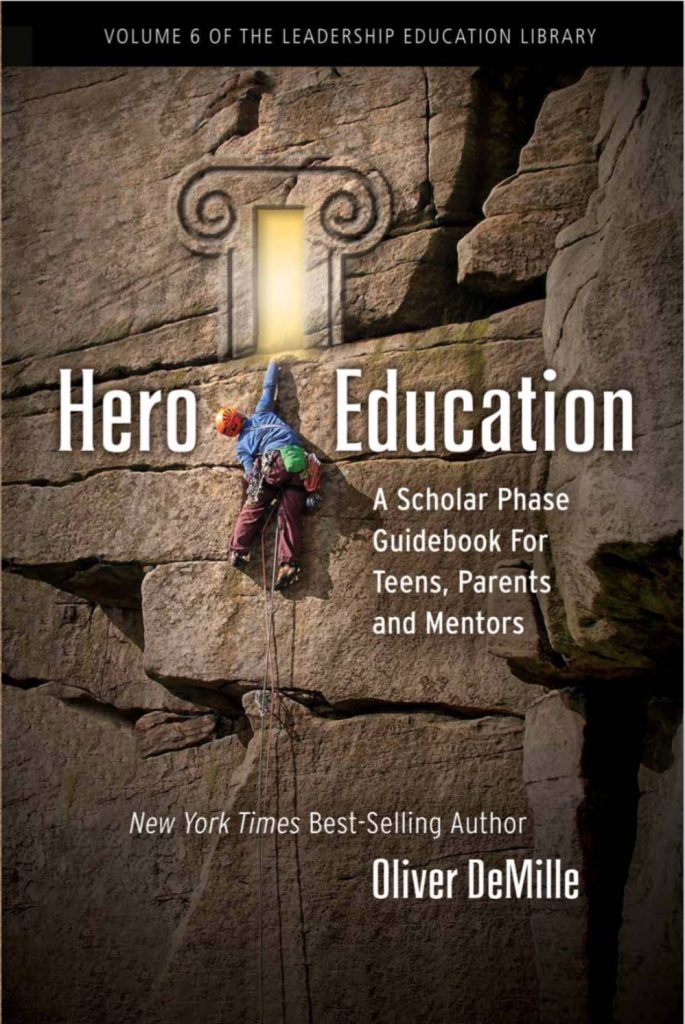 Despite some real progress for a few families and youth in this arena, for far too many of today’s young people the generational tide continues in the direction of easy or easier, adult-sanctioned snowflake weakness, trophies for everyone, and a culture of “blame your parents” (or your teachers, or anyone but yourself), “embrace feelings of unearned entitlement”, “turn to the government to fix anything you don’t like”, and “never take the hard path of extreme work, sacrifice, risk, and great achievement”. More and more parents are realizing the problem—the disaster, really—with this approach, and looking for an antidote.
Despite some real progress for a few families and youth in this arena, for far too many of today’s young people the generational tide continues in the direction of easy or easier, adult-sanctioned snowflake weakness, trophies for everyone, and a culture of “blame your parents” (or your teachers, or anyone but yourself), “embrace feelings of unearned entitlement”, “turn to the government to fix anything you don’t like”, and “never take the hard path of extreme work, sacrifice, risk, and great achievement”. More and more parents are realizing the problem—the disaster, really—with this approach, and looking for an antidote.
We have personally witnessed this generational struggle as we have promoted the principles of great education in our Thomas Jefferson Education (TJEd) system. Our call for Scholar Phase, an intense teen study program of voluntarily putting in massive effort and work to earn a truly great education, is often considered unrealistic by the old guard. But it has been revolutionary and incredibly successful for those (Millennial/Z’s and parents) who have risen to the challenge.
We have seen firsthand that many teens can do very, very hard things.[29] Moreover, once they get a taste for it, they frequently fall in love with the challenge.[30] This inspired me to write the book Hero Education, which builds on the theme of young people accomplishing great things by voluntary action, personal initiative, and hard work. Also, in our experience with TJEd, the best results frequently come where parents and mentors not only encourage great effort, but also lead the way—showing their teens what to do by personal example.
PART II
A RADICAL (AND SURPRISING) SUGGESTION!
“Did you ever wish with all your might that something would happen, and wait for it, expect it, and long for it, and nothing did, until it grew so bad, it seemed as if you had to go on another minute you couldn’t bear it?” —Gene Stratton-Porter, Laddie
 I recently read a report that encouraged even more success of this type. It was both intriguing and fascinating. It may be the best thing I’ve read specifically on the challenges of Millennials and Gen Z (and helicopter vs. leadership parenting) since Allan Bloom’s The Closing of the American Mind. It is found in Outside magazine, and entitled: “Rewilding the American Child.”
I recently read a report that encouraged even more success of this type. It was both intriguing and fascinating. It may be the best thing I’ve read specifically on the challenges of Millennials and Gen Z (and helicopter vs. leadership parenting) since Allan Bloom’s The Closing of the American Mind. It is found in Outside magazine, and entitled: “Rewilding the American Child.”
That’s right:
re – wild – ing
Emphasis on “wild”.
I’m so intrigued by this concept that whenever I think of it I feel this word needs a good ! ! ! to punctuate it effectively. And note that the word “rewilding” is an active verb, like learning, reading, discussing, or loving.
Or jumping, running, hiking, swimming, etc.
Profound.
The report begins:
“Overscheduled.
“Addicted to screens.
“It’s time to set our kids free.”[31]
Freedom. What a great idea. Especially applied to education.
Indeed, the recommendations go a step past free-range childhood—all the way to the wilds. Literally.
From the report:
 “Our children are in crisis…. creating a generation of entitled wimps…. Today, America’s kids are caught up in one of the largest mass migrations in human history: the movement indoors.”[32]
“Our children are in crisis…. creating a generation of entitled wimps…. Today, America’s kids are caught up in one of the largest mass migrations in human history: the movement indoors.”[32]
This is a momentous statement. Take a moment to re-read the last quote and let it sink in. This is big. Here’s more:
“Only recently have we begun to spend our lives penned in by walls, staring at screens.”[33]
Indeed, we’re living through a major development in human history. The full ramifications of this alteration from all past history are yet unknown, but it is already clear that the rise of institutionally-designed “wimpy-ness” is both real and, unless something changes, “the new normal.”
 The impact on society is drastic. This shift has coincided with a rise in the average age of young people becoming independent—with increased dependence in where they live, their finances, and their emotional development. In a reversal of progress, 30 is now the new 18. Adulthood is increasingly put off until later. Marriage, having children, accepting increased career responsibility—all are procrastinated by the bulk of Millennials. And Z’s are following suit.
The impact on society is drastic. This shift has coincided with a rise in the average age of young people becoming independent—with increased dependence in where they live, their finances, and their emotional development. In a reversal of progress, 30 is now the new 18. Adulthood is increasingly put off until later. Marriage, having children, accepting increased career responsibility—all are procrastinated by the bulk of Millennials. And Z’s are following suit.
The “Rewilding” report recommends things that will seem extreme to some, reckless to others, but get right to the core of what many consider the problem of the so-called “Wimpy Generation”.[34] These suggestions include:
“It’s time to make childhood an adventure again. Kids deserve the chance to explore nature without an agenda or a chaperone, to take risks and learn to get themselves out of trouble, to fall in love with nature…”[35]
I’m reminded of something penned by Lord Byron:
“There is pleasure in the pathless woods, there is rapture in the lonely shore, there is society where none intrudes, by the deep sea, and the music in its roar. I love not man the less, but Nature more.”[36]
A generation that seldom spends real time in the real out-of-doors is deprived of so much, too often oblivious to large swaths of learning and therefore to key parts of life, self, and purpose. Another important quote, this one from Henry James, further illustrates the challenge:
Summer afternoon–summer afternoon;
to me these have always been the two most beautiful words
in the English language.[37]
But if we’re caught in the Trapped-Indoors rut, summer differs very little from any other season. Screens are all that matter. Trees, waves, leaves, clouds, rain, even books in many cases, are foreign. Alien even.
What kind of education, or life, is this?
“Look deep into nature,” Albert Einstein is credited with saying, “and then you will understand everything better.”[38]
 Years ago I took a group of college students on a field trip many hours from home. We stayed one night at a beautiful old estate, and when we first arrived we walked through the house and around the grounds. Almost immediately, as we moved into the large fields at the back of the home, one student noticed a huge old tree and gleefully ran to it and climbed up the branches far above the ground. Several other students followed her, and they sat together in their leafy perch and talked for hours about the books we were covering in class at the time, the connections of these books to life, and other important ideas.
Years ago I took a group of college students on a field trip many hours from home. We stayed one night at a beautiful old estate, and when we first arrived we walked through the house and around the grounds. Almost immediately, as we moved into the large fields at the back of the home, one student noticed a huge old tree and gleefully ran to it and climbed up the branches far above the ground. Several other students followed her, and they sat together in their leafy perch and talked for hours about the books we were covering in class at the time, the connections of these books to life, and other important ideas.
I recently returned to the same estate, and pointed out the great tree to a couple of my own children. They marveled at it, as did I. As they climbed, I found myself surprised that more than a decade earlier I had never even considered the safety of those climbing the tree. The world has changed much during the ensuing years, and in the current environment I quickly realized that an extreme focus on safety would have been one of my first concerns if that event had happened today. To the point that I’m sure I would have told the students to climb down immediately.
That would have been tragic. Yet in our sadly “unwilded” and “newly indoor” world, things have changed, and not for the good. “The undiscovered country”, Shakespeare told us, “from whose bourn No traveller returns.” He was speaking, of course, of death. But could the same thinking be applied to the Generation of Screens—once in their grip, No Traveller really returns? Are we now prisoners of the walls and silicon processors that so dominantly define our age and control so many of today’s values?
Perhaps this goes too far, but does our concern about the loss of nature for so many young people extend far enough? Are we even aware of the problem?
One of the best things about the “Rewilding” report is that is doesn’t fall into the almost universal modern educational trap of recommending a solution for the kids only—while the parents stay inside with their thumbs addictively swiping screens. The parents are in fact counseled that to really see a change in their youth they’ll need to lead the way, by showing “them that we, too, love to play outside.”[39] If we added the words “work” and “read” to this sentence, it would be almost ideal. Plato and Aristotle would agree, I think. Thomas Jefferson, whose two favorite pastimes were walking in the wilds and reading, would certainly approve.
 The report recommends a number of options for “rewilding” our kids, including:
The report recommends a number of options for “rewilding” our kids, including:
- “Explore together”
- “Establish Boundaries”
- “Work the Farm”
- “Take back roads…”
- “Fuel their love of games…”
- “…go rafting, take backcountry ski trips, and spend long days hiking…”
- “Age-Appropriate Adventure”
- “A Deep Connection With Animals”
- “Make Sports Fun Again”
The report in Outside magazine, the September 2018 issue, elaborates on all of these and includes many more suggestions; I highly recommend it. The report notes that it is of course important to establish effective safety and other guidelines and rules in all of this, and to make good choices. (Such a disclaimer is probably NECESSARY if Boomers and Gen Xers are reading. But it increasingly appears that risk is the major ingredient missing in the lives of what so many consider the Wimpy Generation.)
In short, with wise planning and implementation, each young person’s education can be greatly improved through outdoor activities…
 HARD STOP. Here is what one Millennial/Z teen told me when I read this article with him (this exact article, the one you’re reading now). He interrupted me at this point, after the disclaimer in the paragraph above, and said: “Fine. But it is just as important, maybe more important, to help them be strong. Far too often, parents equate ‘safe’ with ‘good’, and the result is just weakness. Many kids are held back by frightened, overprotective parents. Our modern society is so skewed to the side of coddling us that strength is usually missing.”
HARD STOP. Here is what one Millennial/Z teen told me when I read this article with him (this exact article, the one you’re reading now). He interrupted me at this point, after the disclaimer in the paragraph above, and said: “Fine. But it is just as important, maybe more important, to help them be strong. Far too often, parents equate ‘safe’ with ‘good’, and the result is just weakness. Many kids are held back by frightened, overprotective parents. Our modern society is so skewed to the side of coddling us that strength is usually missing.”
When I tried to point out the need for balance in this, he interrupted again: “In truth,” he said, “strength is ultimately the only safety. Adults know this. But they act like their kids will never need to be strong.”
I tried to reiterate my point about balance, and he shook his head. “Listen to me. At some point, the kid will have to walk out into the real world. Period.” Then, after a pause, “Prepare them now. That’s what we need from parents.”[40]
THE LONELY
“‘Difficulty’ is the name of an ancient tool
that was created purely to help us define who we are.”
—Paulo Coelho
 The “Rewilding” report also points out another truly profound reality:
The “Rewilding” report also points out another truly profound reality:
“Today’s kids are lonelier than any previous generation.”[41]
This rings all too true to anyone who works a lot with youth. Modernity has taken its toll. The constant connection with screens, and indoor physical separation from other people, too often gets in the way of other more important connections—with parents, siblings, pets, nature, mentors, hobbies, work toward great goals and passions, books, talents and interests, challenging problems and overcoming them, the kind of lessons that are learned only from struggle, etc. These are seldom the skills learned on screens.
A funny joke circulating on the Internet reads something like this:
The Wi-Fi in my house went down for a few minutes
I had to spend time with my family.
They seem like good people…
But is this really funny? In Millennial/Z humor, the several youth I’ve asked assure me, it’s hilarious. For the rest of us, it’s pretty dark. (When one of my Millennial daughters read this, she said the whole joke was actually terrible. Why? Because she was horrified that the Wi-Fi went out at all. “That’s infuriating!” she exclaimed. Another daughter’s big concern was why the person didn’t have data on their phone so they could stay on the Internet even without Wi-Fi. What is she talking about????)
 Humor aside, today’s epidemic of so many teens and twenty-somethings (and even some in their thirties) who put off adult responsibility and remain weakly dependent on authority figures for…well, almost everything…may well be a natural result of the migration indoors.[42] The “snowflake” view of so many on college campuses is indicative of this trend. What is needed in today’s world—our homes, our communities, our learning environments—is a major injection of grit.[43] Of initiative, stamina, guts, and tenacity. And these things are nearly always learned away from screens.
Humor aside, today’s epidemic of so many teens and twenty-somethings (and even some in their thirties) who put off adult responsibility and remain weakly dependent on authority figures for…well, almost everything…may well be a natural result of the migration indoors.[42] The “snowflake” view of so many on college campuses is indicative of this trend. What is needed in today’s world—our homes, our communities, our learning environments—is a major injection of grit.[43] Of initiative, stamina, guts, and tenacity. And these things are nearly always learned away from screens.
In short, technology is a wonderful and powerful tool; few would dispute this. But it is not the only wonderful and powerful tool. A list of tools that are even more wonderful and more powerful include those just outlined above: parents, siblings, pets, nature, mentors, hobbies, work toward great goals and passions, books, talents and interests, challenging problems and overcoming them, the kind of lessons that are learned only from struggle, etc.
The great challenge—and fix—for Millennial/Z’s is to find and implement the right combination of ALL these tools. To be honest, this is true for non-Millennials as well. Put simply, it’s time to re-open the American mind. And get outside…a lot.
Note that doing this is going to be hard. Which is exactly what we need.
“…what you learn there doesn’t amount to a hill of beans compared to what you can find out yourself outdoors. Schoolhouses are made wrong. If they must be, they should be built in a woods pasture beside a stream, where you could wade, swim, and be comfortable in summer, and slide and skate in winter. The windows should be cut to the floor, and stand wide open, so birds and butterflies could pass through. You ought to learn your geography by climbing a hill, walking through a valley, wading creeks, making islands in them, and promontories, capes, and peninsulas along the banks. You should do your arithmetic sitting under trees…”
—Gene Stratton-Porter, Laddie
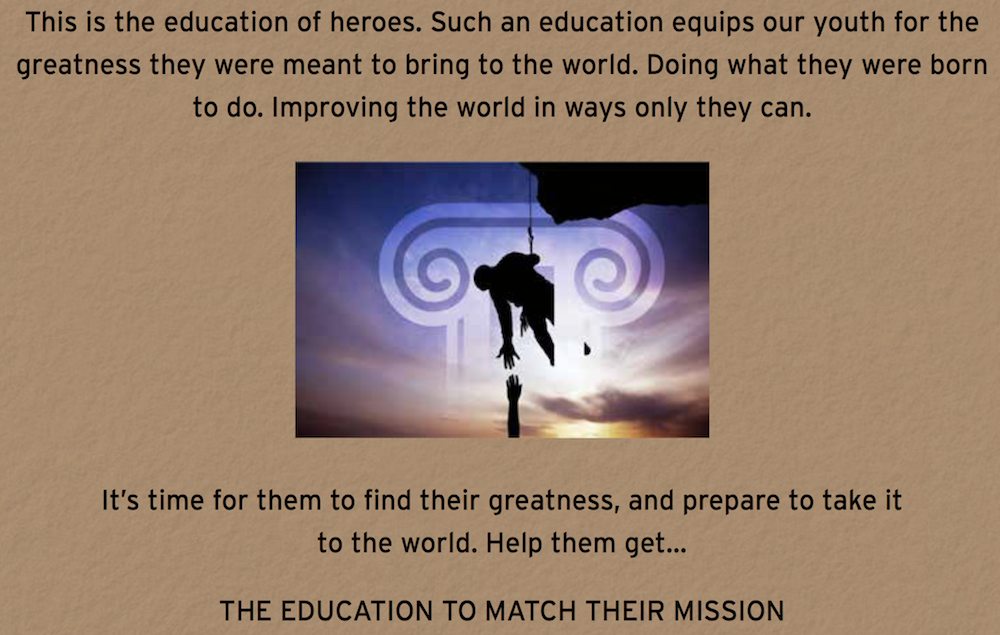
(For more on this topic, especially real solutions, see Hero Education by Oliver DeMille)
(For a Funny Video Click Here>>)
[1] Time, Joel Stein, May 9, 2013
[4] The Atlantic, Greg Lukianoff and Jonathan Haidt, September 2015
[10] The Atlantic, James Fallows, January/February 2015, citing Gallup
[13] The Atlantic, James Fallows, January/February 2015
[14] See The New York Times, Damien Cave, June 3, 2005.
[15] Military1.com, March 6, 2018
[18] American Institute for Economic Research, Max Gulker, December 2017, “Over Half of Millennials Identify as Socialist: Here’s How to Change Their Minds”
[19] See, for example: The New York Times, Michelle Goldberg, June 30, 2018, “The Millennial Socialists Are Coming”; The American Interest, Ben Judah, “What Is Millennial Socialism?”; chicagotribune.com, Heather Wilhelm, July 9, 2018, “Why are millennials so hot for socialism?”
[20] Ibid.
[21] Ibid.
[22] Ibid.
[23] See Politifact, Andy Sherman, February 13, 2018
[24] Independent.co.uk, Rachel Hosie, February 7, 2017
[25] See for example Battle Hymn of the Tiger Mother, by Amy Chua, Bringing Up Bėbė, by Pamela Druckerman, and “Are ‘Tiger Moms’ Better than Cools Moms?” (The Atlantic) by Julia Ryan, among others.
[26] Independent.co.uk, Rachel Hosie, February 7, 2017
[27] Parents.com, Melissa Willets, “6 Parenting Trends to Look Forward to in 2016”
[28] Wikipedia.org, “Free-range parenting”
[29] See Hero Education, Oliver DeMille
[31] Outside, multiple authors, September 2018
[36] Cited in Forest Therapy, 2018, by Sarah Ivens
[39] Outside, multiple authors, September 2018
[40] Ephraim DeMille (age 18 – son of my brother, William), August 2018
[41] Outside, multiple authors, September 2018
[43] See the following: Angela Duckworth, Grit; Claude Hamilton, Thick-Skinned; Claude Hamilton, Toughen Up.
Category : Blog &Citizenship &Community &Culture &Current Events &Economics &Education &Entrepreneurship &Family &Generations &History &Information Age &Leadership &Liberty &Mission &Producers &Prosperity
The Jefferson-Madison Debates: The Third Layer
July 17th, 2018 // 7:08 am @ Oliver DeMille
“When technology advances too quickly for education to keep up,
inequality generally rises.”
—Eric Brynjolfsson and Andrew McAffee
“Your true greatness comes when you focus not
on building a career but on finding your quest.”
—Vishen Lakhiani
“Engaged students are 16 times more likely to report being academically motivated than students who are not engaged. Finding ways to engage the 40% of students who are not engaged would have a significant impact on their academic motivation.”
—Quaglia Institute
Foundations
 Education is like a map. Or, more precisely, it mirrors the entire field of maps and map-making.
Education is like a map. Or, more precisely, it mirrors the entire field of maps and map-making.
Understanding the massive change now occurring in how we make and learn from maps is in many ways directly applicable to the coming changes in education. And like in education, many people in the older generations (born before 1980, or even 2001), don’t understand that a major revolution is ahead—one so big that what we call a “map” today won’t even qualify as a map in twenty years. (And much of what we call an “education” today won’t even count as education two or three decades from now.)
The pre-modern map (Layer One) emphasized the physical traits of the earth: continents, oceans, seas, rivers, mountain ranges, islands, etc. More advanced pre-modern maps included things like ocean currents, the altitudes of mountain peaks, and the trade routes most effectively used by overland and shipping merchants.
During the modern era, we added governments to our maps (Layer Two): national borders, towns, cities, capital cities, provinces, states, counties, etc. This was part of the great shift from pre-modern to modern. Governments and their jurisdictions became as prominent in world affairs as the natural physical features of the earth. People using maps needed to know what government they’d be dealing with in a given spot as much as where the ocean currents would take them and what mountains or rivers they’d need to traverse.
Further Up and Further In
The current shift from modernism to post-modernism is equally momentous. Our maps now require another set of symbols, colors, and words—to tell us what we need to know about our world. The physical features on the maps (continents, oceans, rivers, mountains, lakes, etc.) are still there, as are the political borders that tell us what government controls each area on the illustration.
But now a third layer of understanding is superimposed on top of the physical and political levels of each map. Most people haven’t even seen such maps yet, so they think of a “map” as something made up of Layer One (mountains, rivers, oceans, etc.) and Layer Two (borders, cities, etc.). They barely fathom what else could be needed.
The post-modern Layer Three is based on what Parag Khanna calls “Connectography.” For example, look at a traditional map of Africa. The Nile is there, and the Cape. The Horn of Africa is obvious, along with the Sahara. There are regions of jungle, and large swaths of savannah. Then there are the many nations and their borders—most of them originally established by European plantation owners. Capital cities are listed in bold letters, the names of nations in larger type.
But where is Layer Three? At its most basic, Layer Three shows highways, airports, and hospitals. In a more detailed Layer Three map, you might find illustrations showing the route of pipelines, Internet cables, or even power lines. These were the simple beginnings of Layer Three maps. A little more advanced Layer Three maps don’t just tell you what road to take, they tell you how long it will take to arrive in current traffic—or redirect you if an accident occurs and is now blocking traffic. They are cast in real-time and they are always changing—truly interactive. Layer Three is a major upgrade.
But more is coming. For example, narrow the map of Africa to Kenya or Ghana. Where are the hotspots of Internet usage? Where are the Internet deserts? What about smartphone usage rates? What food is shipped to a place, and can you get the kind of banana and cereal you want while you are visiting? If you want salmon for dinner, will what you are served be farm raised or wild? – Come from the Atlantic or the Pacific? What nation’s laws governed the fishermen who caught your dinner? Such information tells you a great deal about the probable quality and freshness of what you’ll be eating, and whether or not to even order it.
Put these on the map, and you’ll begin to see how Kenya, Ghana, or any other nation in Africa, or anywhere else in the world, is actually connected. Not understanding such connectivity—or its absence in a certain area—is akin to not knowing what the political lines denoting borders signify on the map. Such ignorance basically renders the user of the map illiterate.
Consider an almost-absurd example, to illustrate:
“Are these lines just very straight rivers?” a total map novice might ask. The laughter that follows is kindly, but surprised. “How can anyone not know about government borders on a map?”
In the future, however, this will apply to much more than national borders.
A Missing Piece
Another Layer Three example is very important: For example, on the map of Kenya, what natural resources are owned by or contractually promised to Chinese companies or the Chinese government? Versus what resources are owned by or contracted to U.S. firms? Or Canadian?, Dutch?, Japanese?, Italian?, British?, French?, German?, Korean?, Indian?, etc. What multi-national companies have their own security forces at work in these places—governing, citing, controlling? Where have they blocked mobile phone and Internet service—and why? If you know the Layer Three map of Africa this way, you’ll understand the world in ways other people simply cannot grasp. As Khanna put it: “China’s relentless pursuit of [natural resource contracts around the world] has elevated…to the status of a global good on par with America’s provision of security.”[i]
In other words, if anything happens militarily in the world, the U.S. is sure to get involved (or at least consider getting involved); and if anything happens concerning natural resources—oil, minerals, food, wood, precious metals and gems, water, etc.—China is sure to jump in. It likely already has contracts signed and sealed. In fact, put alliances and treaty requirements on the map, and something stands out: China owns numerous economic resources around the globe that the U.S. does not. Moreover, as of 2015 the United States was bound by treaty to defend 67 nations in the world; China was only bound to protect 1.[ii]
In short, a lot of global resources and money are slated to flow to China in the decades ahead (it has already begun), while huge assets and cash are scheduled to flow away from the United States. One has an economy that is programmed to head up, the other down. If you don’t consult a Layer Three map, this information is unknown.
Look at the map with the Layer Three approach, however, and the future becomes immediately clear: It belongs to China. The U.S. and Europe[iii] are falling further and further behind. This is obvious on a Layer Three superimposition.
But remove Layer Three and all you have are the continents, oceans, lakes, mountains, political borders, cities and towns. Nothing about Levels One or Two tell you that China is on the rise—with contracts across the globe, and a growth rate in ownership of natural resources and supply chains for these resources that all but assure them monopoly status in the decades ahead. And this example, China, is only one of the many hugely important things missing from Layer Two maps—which are the only ones most of us ever engage.
To reiterate: the pre-modern and modern maps fail us. They don’t even tell us what we need maps to communicate (rather than merely travel) in order to help us make the best local decisions. As a result, the old maps are almost worthless. They are historical relics, but not the most effective tools of decision-making or strategy.
For that, we need Level Three maps superimposed on the older models. As Joshua Cooper Ramo put it: “Ball up your right hand into a fist. Take your left hand and open the fingers wide. Hold the hands a few inches apart. You can think of your left hand as the vibrating, living network of connection and your balled-up fist as concentrated power. Right hand, Google Maps; left hand, millions of Android phones. This is the picture of our age.”[iv] But it is only an early picture. By the time you read this, will Google Maps and Android phones be replaced by something more advanced? Not unlikely.
What is Not Seen
Again, most people today have no idea this is happening. At least not at this scope, or pace. Many feel a general sense of a rising challenge, even a threat, from China, for example. But they don’t know what it means, why it is real, or how it is developing. They have no clue how to prepare for or address it.
The same is true of education. To wit: geography is still taught in two layers—much like it was in the 1960s. Technology makes it easier to teach and learn, but Layer Three tools and Layer Three thinking are absent in all but a very few out-of-the-box classrooms or learning environments. As Toffler put it, too many of today’s young are being raised to show up on time, do repetitive tasks without complaining, follow instructions, and memorize a great deal of knowledge without deeply understanding it. This is the focus of most schools.
These three lessons—punctuality, repetitive work, and rote memorization—routinely pass for what we call “education.” They are, in fact, the key lessons of schools in modernism. The pre-modern era emphasized “the 3 R’s: readin’, ’ritin’, and ’rithmetic,” and these prepared the young for success in the agrarian economy. Likewise, the three lessons above were often effective training for landing and keeping a job during the industrial age.
But today’s emerging information economy demands something different. Success now demands the Third Layer of education. It includes the kind of knowledge learned from the 3 R’s and also post-World War II schooling in history, literature, math, science, and social studies, but it also superimposes a Third Layer of education as well, which is more attitudinal and skills based: initiative, innovation, creativity, resilience, ingenuity, tenacity, recognizing opportunities, go-getter-ness, and entrepreneurial risk-taking.
The Third Layer is as different from most modern public and private schooling as the typical 1960s, 1980s, or 2000s high school or elementary was from the one-room schoolhouse. If the pre-modern age gave us Mary and Laura in the Little House series, studying at home or the local school (which was also the town hall, town theater, and community church), the modern age gave us the high school of Pretty in Pink, The Breakfast Club, High School Musical, Dead Poet’s Society, One Tree Hill, 90210, or even 22 Jump Street.
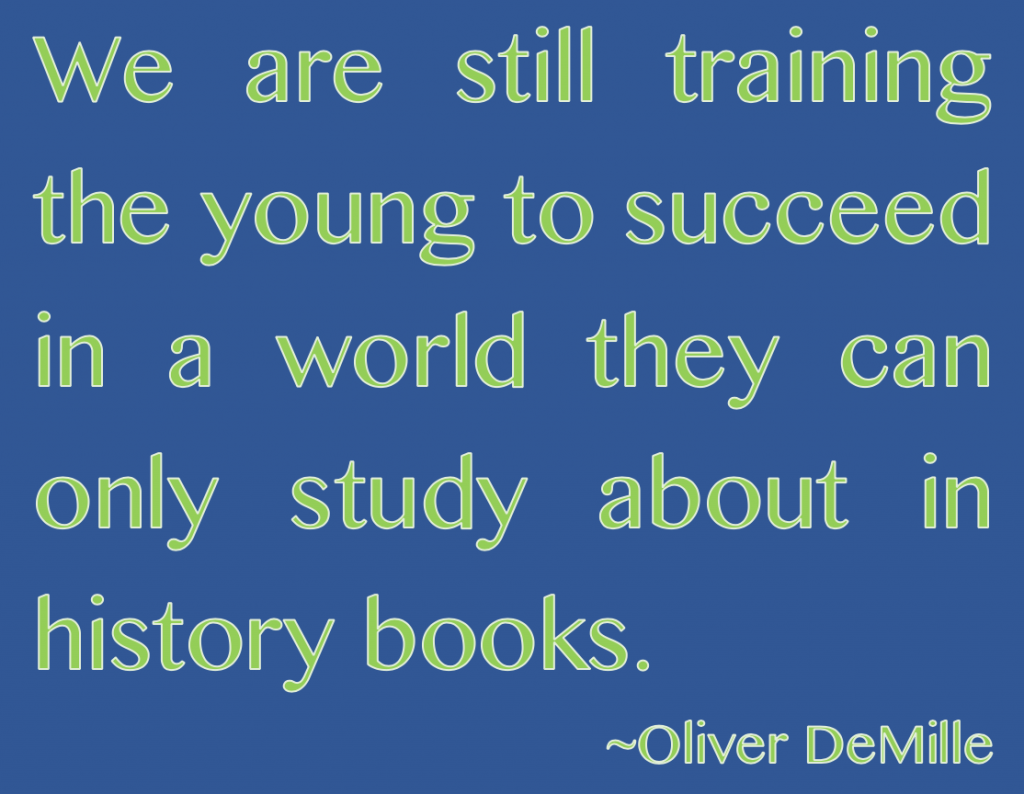 All are outdated now. All fail to prepare our nation’s youth for the actual economy of the 21st century. We are still training the young to succeed in a world they can only study about in history books. Indeed, it is no exaggeration to note that the more time they spend in the modern school system, including the increasingly outdated university campus, the less prepared they’ll likely be to compete effectively in the rough-and-tumble emerging global marketplace with its worldwide competition and demands.
All are outdated now. All fail to prepare our nation’s youth for the actual economy of the 21st century. We are still training the young to succeed in a world they can only study about in history books. Indeed, it is no exaggeration to note that the more time they spend in the modern school system, including the increasingly outdated university campus, the less prepared they’ll likely be to compete effectively in the rough-and-tumble emerging global marketplace with its worldwide competition and demands.
For example, a university degree isn’t what it used to be: The average graduate from the class of 2016 had $37,000 in student debt and couldn’t get a decent job in his or her field—or in any other equivalent field. There are of course exceptions, but the numbers of those leveraging college degrees into effective careers significantly decreases each decade (Note: in North America, Europe, and Latin America, but not in China). In short, today’s young adults are too often receiving a Layer Two education in a world that demands Layer Three knowledge, choices, and skills.
Past, Present, and Future
Few current students are being taught the skills of success that are needed in the new economy. The real economy. Layer Two schools simply do not teach initiative, ingenuity, or innovation. They don’t purposely teach chutzpah, audacity, grit, wise risk-taking, entrepreneurialism, or nerve.
Note that these are precisely the character traits that made America the world’s superpower. And Britain before her, and earlier, Spain and Portugal. These are the very traits that put Egypt at the top, then the Greek city states, and later Rome. These are the characteristics that gave the Gauls, Franks, Anglos and Saxons their edge.
They didn’t have Layer Three maps, to be sure, but they engaged in their era’s “Layer Three” education of the youth, teaching them the skills of resourcefulness, inventiveness, and daring in the face of difficulties. Some of these societies emphasized good purposes (such as life, liberty, and the pursuit of happiness, etc.), while others embraced less noble goals (aristocratic rule of an elite class over the rest of the people, dominance over neighboring nations, a pursuit of wealth through violence, etc.).
But whatever their dreams—good or bad—it was Layer Three skills (initiative, boldness, pluck, enterprise) that lifted every great-power nation in history to the top. As the society that now holds this spot, we (North America, and to a lesser extent Europe) are stunningly lax about teaching these traits. We increasingly downplay them as unimportant and even unattractive. Even “against the rules”. As a result, we have lost our edge. We have largely lost our drive. Too many modern Americans have lost our shared vision and purpose. Unity is a thing of the past.
Indeed, Americans were once unified in the goal to spread freedom, opportunity, and prosperity to the world. Now, the best we seem to be able to muster is a hope to afford college for our kids, and that they’ll get a safe, secure career with good benefits—and as little fuss or struggle as possible. Most colleges themselves seem committed to shielding our young adults from challenges, difficulties, thinking, and any diverse or challenging ideas. This is not the behavior of a nation on the rise. It is the opposite. To paraphrase C.S. Lewis, we are castrating the stallions of the younger generations, then hoping they’ll be fruitful.
But apply Layer Three to the map. Where in the world do we find whole populations burning passionately with drive, initiative, innovation, nerve, entrepreneurial risk-taking, resilience, a hunger to achieve, audacity, ingenuity, resolve, and tenacity? Where do we find the largest concentrations of people who thrive in the face of uncertainty and embrace whatever is hard, and flourish even in an environment of impermanence and difficulty?
When you find a lot of people who have these traits, note where they live. Not in North American or Europe (at least not in large concentrations). In our modern American schooling/career system, for example, our major focus seems to be avoiding uncertainty, impermanence, and difficulty—yet these are the unavoidable realities of the global economy.
Through the Magnifying Glass
Look even closer. Enter this data electronically on a map and you’ll find these traits in China. Indeed, the heartbeat of China is a new “eye of the tiger.” A similar fire burns in India, and a less populated but angrier flame blazes across the Middle East. Layer Three also shows us the rise of such passion in parts of Latin America, Africa, and Russia. These are trigger-points of the decades just ahead.
Where such passion does show up in North America—from California to British Columbia, from Texas to New Hampshire to Newfoundland to Florida, it is usually personal, career-oriented, and commercial. A better job. A marketable education. A promotion.
These hardly match the resolve or intensity of China and its new economic allies across the developing world. They want to lead the world, change the world, and do great things. They want victory, and they see their lives as part of a battle.
In Europe the irony is even more pronounced. The Layer Three map shows numerous pockets of extreme passion in the nations of the E.U.—but zoom in, and you’ll note that most of the people with this kind of fire in the belly are usually recent immigrants from the Southern half of the globe.
The one great exception in North America and Europe is the entrepreneurial class, those who Steve Jobs called the dreamers, the rebels, and the risk-takers. They graduate from college and reject job offers from the Fortune 500 to pursue risky start-ups or launch non-profit charities. Or, increasingly, they skip college altogether, or drop out, and get started on their business or charitable ventures even younger, with an edgier, more idealistic and relevant education.
Their Layer Two parents and grandparents try to talk them out of such endeavors, but these young people have a hunger that typical education and careers won’t fill. They are a Remnant, throwbacks to the earlier Americans who got on the Mayflower, worked and died in Jamestown, went West by horseback or wagon to explore, start, create, and change things. They are the New American Founders, enlightened and ennobled by hindsight of the mistakes of the past, and impassioned by their view of the future – and we desperately need them.
We need a generation of them.
Now.
In the Now
If you are one of their parents or grandparents—worried that your youth are making such choices, decisions that make no sense to you—you can relax. Yes, the kind of risky leadership they are engaging is scary to the older generations who were raised to seek security. But the Third Layer maps clearly show that we no longer live in an era of security.
Even young people who follow the traditional path of college and career suggested by their elders will find that for most people it doesn’t endure in the new economy. We are in an era of tumult, change, and uncertainty—and this is only going to increase for the next few decades.
Those who try to live by Second Layer rules will fall further behind. College degrees won’t bring most of them secure jobs, and seemingly secure careers will suddenly be lost to recessions, new technologies, outsourcing, mergers, regulatory changes, companies sold to foreign investors, and competition, along with a host of other unforeseen realities.
Indeed, those who will do the best in the new economy—whose contributions and livelihoods will end up being the most secure—will be the new entrepreneurial class. The innovators. The roll-with-the-punches change agents. Those who can think, lead, initiate, and wisely assess risk. We are indeed entering the Age of Risk, and this massive shift in the world economy is here to stay. Business has already caught on and is changing things to meet the new reality. But education is still in denial, along with most in government.
Sadly for those who allow themselves to be swayed by the current denial of many in the educational sector and Washington, people caught in Second Layer thinking will be the losers of the next thirty years. The winners will be Third Layer risk takers who tenaciously create ways to succeed in the new environment. Who make a way.
Many of them are already looking at the world through the lenses of Third Layer maps and mindsets, and they understand something very real: The future is theirs. Moreover, our future is in their hands.
The more we can do to help and support them, the better things will turn out for all of us. The successes and failures of our entrepreneurs will determine the future. Just as it has determined the past.
Fall or Rise
This reality causes serious concerns. Anyone who takes a good look at the current university campus model of learning finds a number of problems. Not the kind of challenges that demand reform, mind you, but rather a systemic, structural network of problems that will require a true educational revolution. The need for change is, to put it lightly, drastic.
Just consider the following commentaries by some of today’s top thinkers on the topic of the emerging economy and its ties to the type of education we now need. For example, MIT’s Eric Brynjolfsson and Andrew McAffee wrote, in a section of their book labeled “Failing College”:
“Richard Arum and Josipa Roska…and their colleagues tracked more than 2,300 students enrolled full-time in four-year degree programs at a range of American colleges and universities. Their findings are alarming: 45 percent of students demonstrate no significant improvement on the CLA [Collegiate Learning Assessment, which tests ‘critical thinking, written communication, problem solving, and analytic reasoning’] after two years of college, and 36 percent did not improve at all even after four years.
“The average improvement on the test after four years was quite small…. What accounts for these disappointing results? Arum, Roska, and their colleagues document that college students today spend only 9 percent of their time studying (compared to 51 percent on ‘socializing, recreating, and other’), much less than in previous decades, and that only 42 percent reported having taken a class the previous semester that required them to read at least forty pages a week and write at least twenty pages total.
“They write that, ‘The portrayal of higher education emerging from [this research] is one of an institution focused more on social than academic experiences. Students spend very little time studying, and professors rarely demand much from them in terms of reading and writing.’
“They also find, however, that at every college studied some students show great improvement on the CLA. In general, these are students who spent more time studying (especially studying alone)…”[v]
The authors also wrote: “The good news, though, is that technology is now providing more…opportunities than ever before. Motivated students and modern technology are a formidable combination. The best educational resources online allow users to create self-organized and self-paced learning environments—ones that allow them to spend as much time as they need with the material, and also to take tests that tell them if they mastered it.”[vi]
Futures Past
The quality of learning in such online venues is very often extremely high. For example, when a graduate level AI course at Stanford was opened to participants on the Internet for free, over “160,000 students singed up for the course. Tens of thousands of them completed all exercises, exams, and other requirements, and some of them did quite well. The top performer in the course at Stanford, in fact, was only 411th best among all the online students. As Thrun [the instructor] put it, ‘We just found over 400 people in the world who outperformed the top Stanford student.’”[vii]
Likewise, “…Laszlo Bock, Google’s senior vice president of people operations, notes that college degrees aren’t as important as they once were. Bock states that ‘When you look at people that didn’t go to school and make their way in the world, those are exceptional human beings. And we should do everything we can to find those people.’ He noted in a 2013 New York Times article that the ‘proportion of people without any college education at Google has increased over time’—on certain teams comprising as much as 14 percent.”[viii]
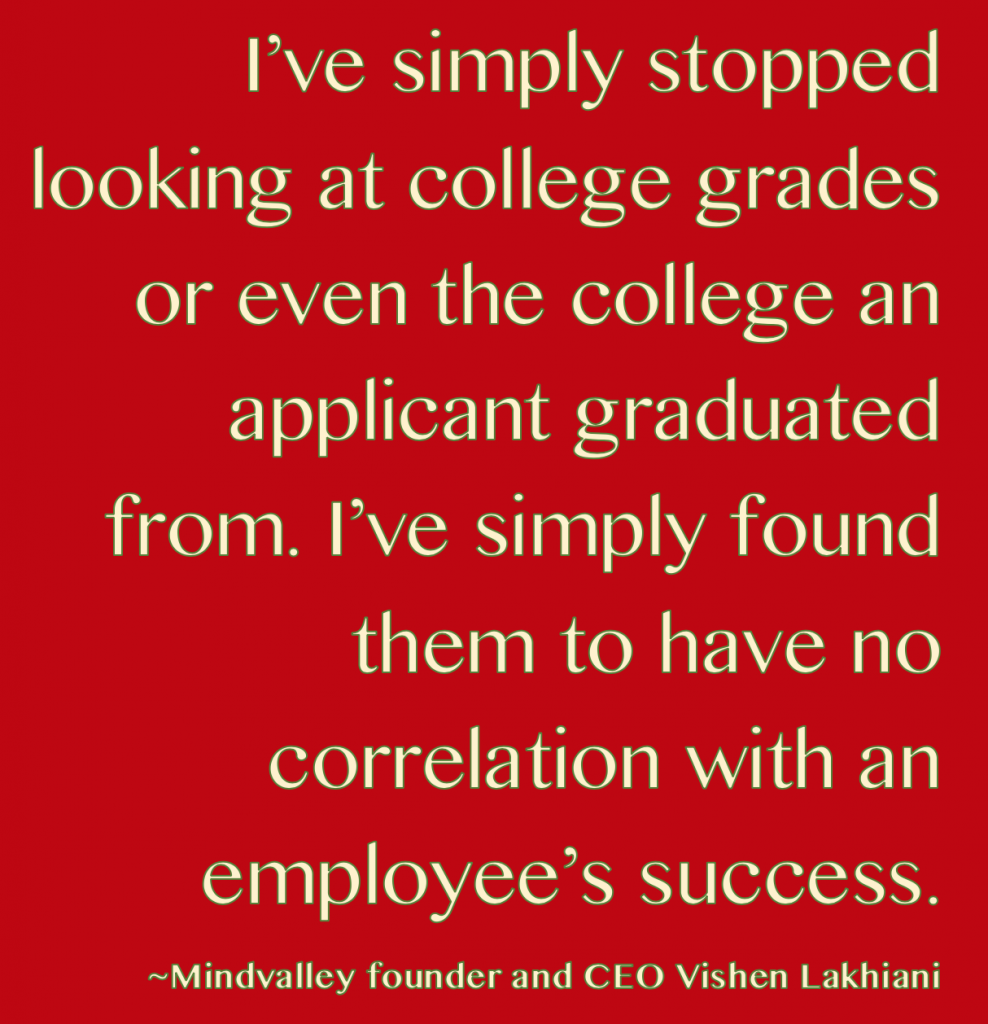 Mindvalley founder and CEO Vishen Lakhiani wrote: “I’ve personally interviewed and hired more than 1,000 people for my companies over the years, and I’ve simply stopped looking at college grades or even the college an applicant graduated from. I’ve simply found them to have no correlation with an employee’s success.”[ix] Sadly, too many people still hold on to old educational models that no longer deliver what they once did, or what they now promise.
Mindvalley founder and CEO Vishen Lakhiani wrote: “I’ve personally interviewed and hired more than 1,000 people for my companies over the years, and I’ve simply stopped looking at college grades or even the college an applicant graduated from. I’ve simply found them to have no correlation with an employee’s success.”[ix] Sadly, too many people still hold on to old educational models that no longer deliver what they once did, or what they now promise.
Lakhiani put it this way: “But here’s the problem. Most of us are using systems that have long [since] become obsolete. As Bill Jensen said in his book Future Strong: ‘Even as we enter one of the most disruptive eras in human history, one of the biggest challenges we face is that today’s systems and structures still live on, past their expiration dates. We are locked into twentieth-century approaches that are holding back the next big fundamental shifts in human capacity.’”[x]
Bestselling author Neil Pasricha told the following story: “A senior partner at a prestigious global consulting firm once said to me after a boozy dinner: ‘We find Type A superachievers from Ivy League schools who need lots of reward and praise…and then dangle carrots just over the next deadline, project, and promotion, so they keep pushing themselves. Over every hill is an even bigger reward…and an even bigger hill.’”[xi] This is enlightening. It’s not the actual education the big corporations are looking for as much as a sense of over-achievement and needing lots of rewards and praise.
Look at this same scenario from the student’s viewpoint. Is this really the career environment we want our young people to pursue? Is this the life we want for them, or the use of their talents that will best benefit the world—or bring them the most fulfillment and happiness? Sometimes, the answer may be yes. But very often, it isn’t.
Billionaire Paypal co-founder and educational innovator Peter Thiel said it even more bluntly: “Higher education is the place where people who had big plans in high school get stuck in fierce rivalries with equally smart peers over conventional careers like management consulting and investment banking. For the privilege of being turned into conformists, students (or their families) pay hundreds of thousands of dollars in skyrocketing tuition that continues to outpace inflation. Why are we doing this to ourselves?”[xii] After happily reminiscing that he eventually took the entrepreneurial path of founding tech companies instead of following his major in graduate school, Thiel said[xiii],
“All Rhodes Scholars had a great future in their past.”
The Next Normal
The modern college/career system, which is increasingly Level Two education in the new economy, is more and more outdated. In the book Platform Revolution, technology experts Geoffrey G. Parker, Marshall W. Van Alstyne, and Sangeet Paul Choudary argue that the old-style university model is surviving largely because government regulations keep true innovators from competing on anything close to a level playing field.[xiv] If this were to change, no doubt online educational platforms would do for education what Amazon has done for bookstores (and other retailers), Uber has done for taxi services, Wikipedia has done to the encyclopedia publishing industry, and online news sources have done to many newspapers.[xv] Again, over 400 online students tested better than the top Stanford student in the exact same class.
Parker, Alstyne, and Choudary wrote: “The long-term implications of the coming explosion in educational experimentation are difficult to predict with certainty. But it wouldn’t be surprising if many of the 3,000 colleges and universities that currently dominate the U.S. higher education market were to fail, their economic rationale fatally undercut by the vastly better economics of platforms.”[xvi]
Just imagine much cheaper and higher quality higher educational offerings for all. Consider the work by Khan Academy,[xvii] Minerva,[xviii] Peter Thiel, and other educational innovators. If the government ever ends the current educational monopoly supporting the old-style conveyor-belt approach to higher education, the results will likely dwarf the kind of change we witnessed with the advent of cable television programs, or when Ma Bell was deregulated and replaced by an entirely different kind of telecommunications.
Parker and his colleagues also noted:
“In the years to come, the spread and increasing popularity of teaching and learning ecosystems will have an enormous impact on public school systems, private schools, and traditional universities. Barriers to entry that have long made a first-class education an exclusive, expensive and highly prestigious luxury good are already beginning to fall.
“Platform technologies are making it possible for hundreds of thousands of students to simultaneously attend lectures by the world’s most skilled instructors, at minimal cost, and available anywhere in the world that the Internet is accessible. It seems to be only a matter of time before the equivalent of a degree from MIT in chemical engineering will be available at minimal cost in a village in sub-Saharan Africa.
“The migration of teaching to the world of platforms is likely to change education in ways that go beyond expanded access—important and powerful as that is. One change that is already beginning to happen is the separation of various goods and services formerly sold as a unit by colleges and universities. Millions of potential students have no interest in or need for the traditional college campus complete with an impressive library, a gleaming science lab, raucous fraternity houses, and a football stadium.”[xix]
They’d rather pay a lot less and get a better learning experience.
Focusing In
“Education platforms are also beginning to unbundle the process of learning from the paper credentials traditionally associated with it.”[xx] The authors note that many students now “…appear to be more interested in the real-world abilities they are honing than in such traditional symbols of achievement as class transcripts or a diploma.”[xxi] They want to learn knowledge and skills that help them achieve their life and financial goals, not traditional symbols that no longer really work in the 21st century economy.[xxii] Results-Based Learning is increasingly in demand.
For example, “A high ranking on TopCoder, a platform that hosts programming contests, will earn a developer a job at Facebook or Google just as fast as a computer science degree from Carnegie Mellon, Caltech, or MIT. Platform-based students for whom a traditional credential is important can often make special arrangements to receive one—for example, at Coursera, college credit is a ‘premium service’ you pay extra for.”[xxiii] Another example is Duolingo, a crowdsourcing foreign language platform that is teaching more people a foreign language than all the students studying foreign language “in high school in the U.S. combined.”[xxiv]
“Once there is an alternative certification [to college degrees] that employers are willing to accept,” Parker and his colleagues affirm, “universities will find it increasingly difficult…. Unsurprisingly, developing such an alternative certification is among the primary goals of platform education firms such as Coursera.”[xxv] Other organizations are trying to build such educational platforms as well, including Udacity, Skillshare, edX, and others.[xxvi] Even top specialty schools, like MIT and Julliard, are offering open enrollment online courses. (Their selling point is often focused on “Learn from the MIT faculty,” or “Learn from the Julliard faculty,” a nod to the new reality that mentoring is becoming even more important than institutionalism.)
No doubt more innovative higher educational options will thrive (and at the high school level as well), until some of them restructure modern education like eBay, Amazon, Facebook, Uber, the Internet, or Google have done for other fields. As far as student learning is concerned, numerous self-produced online tutorials, on platforms like YouTube and others, provide excellent educational opportunities—both to learn and teach.
All of these developments and trends are part of Third Layer education, and they are almost universally moving away from outdated traditions, methods, and beliefs of conveyor-belt-style education and schools. A new economic era is already here, and for those who know what to look for, new educational models are rising to support what is now needed. Third Layer, Results-Based learning is the future of effective education. The focus is on individualized learning, thinking, and applying rather than conveyor-belt schooling.
The new maps are here, if we’re willing to look.
(This topic is addressed in more detail in Hero Education by Oliver DeMille, available here>>)
[i] Parag Khanna, 2016, Connectography, xvii.
[ii] Harper’s Index, Harper’s Magazine, September 2015.
[iii] The Brexit and election of Donald Trump didn’t seem to make much difference in this trend. See, for example, Geoffrey Smith, “The Brexit Crisis That Wasn’t,” Fortune, October 1, 2016; See also, Jeff Immelt, “After Brexit, Global is Local,” Fortune, August 1, 2016, 71-72.
[iv] Joshua Cooper Ramo, 2016, The Seventh Sense, 122.
[v] Erik Brynjolfsson and Andrew McAfee, 2014, The Second Machine Age, 197-198.
[viii] Cited in Vishen Lakhiani, 2016, The Code of the Extraordinary Mind, 24.
[xi] Neil Pasricha, 2016, The Happiness Equation, 150.
[xii] Peter Thiel, 2014, Zero to One, 36.
[xiv] See Geoffrey G. Parker, Marshall W. Van Alstyne, Sangeet Paul Choudary, 2016, Platform Revolution, 263-268.
[xvii] For example, see commentary in Brynjolfsson, 199.
[xviii] For example, see commentary in Parker, 268.
[xxvi] See, for example, ibid., 265.
Category : Blog &Business &Citizenship &Community &Culture &Current Events &Economics &Education &Entrepreneurship &Generations &Government &History &Independents &Information Age &Leadership &Liberty &Mini-Factories &Mission &Politics &Producers &Prosperity
The Jefferson-Madison Debates: The Next Civil War?
May 13th, 2018 // 4:25 pm @ Oliver DeMille
True or False…or False?
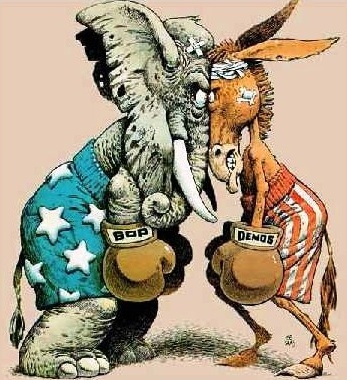 It’s getting worse. Just watch the news. This phrase, the “Next Civil War”, was recently used by economic forecaster Harry Dent to describe the growing divide between Red and Blue state cultures. These two sides now disagree with each other to the point that in many cases people experience real hatred for those on “the other side”.
It’s getting worse. Just watch the news. This phrase, the “Next Civil War”, was recently used by economic forecaster Harry Dent to describe the growing divide between Red and Blue state cultures. These two sides now disagree with each other to the point that in many cases people experience real hatred for those on “the other side”.
Former president Barack Obama noted that people who largely get their news from the mainstream media and those who get their news mostly from Fox are basically living “on different planets.” They not only disagree on principles and solutions, he pointed out, but they fundamentally disagree on “facts”. What the Blue culture sees as incontrovertible truths, the Red culture frequently sees as lies. Fake. False. And the opposite is just as true: what the Red culture sees as fact is often considered false by Blue culture.
No wonder the two sides are so angry at each other. When you disagree on what the facts are, the solutions promoted by the other side frequently appear ludicrous. Even dangerous. Both sides, each rooted in its own understanding of reality, watch the other side say and do things that are clearly and painfully hurtful—according to the set of obvious but differing “facts” they each believe.
Roadblocks
This divide is widening. We’ve reached the point that one of the worst things parents can learn about their child’s “significant other” or new fiancé is that he/she is a Republican, or Democrat—depending on the family. Religion, career, ethnicity, education, financial status, and even a criminal history, are largely negotiable in most modern families. But the other political party? Many parents turn Tevye: “If I try and bend this far, I’ll break.”
Lynn Vavreck wrote in The New York Times (January 31, 2017): “In 1958, 33 percent of Democrats wanted their daughters to marry a Democrat, and 25 percent of Republicans wanted their daughters to marry a Republican. But by 2016, 60 percent of Democrats and 63 percent of Republicans felt that way.” And for many, the feelings run very deep. While in 1994 21 percent of Republicans viewed Democrats in the “Very Unfavorable” category, by 2016 the number was 58 percent. (Pew Research Center) In 1994 17 percent of Democrats saw Republicans as “Very Unfavorable”, but the number in 2016 had skyrocketed to 55 percent. (Ibid.)
Aaron Blake summarized this concern in The Washington Post: “If 58 percent of Republicans hate Democrats and 55 percent of Democrats hate Republicans, that would mean about 35 percent of registered voters hate the opposite political party.” (June 19, 2017) “But that’s not quite hate…. 45% of Republicans see the Democratic Party as a threat to the nation’s well-being…. [and] 41% of Democrats see the Republican Party as a threat to the nation’s well-being”. (Ibid.) When you add independents, the “hate” one of the parties (those who see the other party as a threat to the nation) makes up 39 percent of registered voters or “About 1 in 4” Americans. (Ibid.)
There are a lot of others who see the other side in an unfavorable light, around 33 percent of additional Republicans (for a total of 91% with “unfavorable” or “very unfavorable”) and 30 percent of additional Democrats (86% with “unfavorable” or “very unfavorable” views). (Ibid.) Note that all of this occurred before the Trump presidency. Again, this divide is real, and deep. In the Trump era the intensity has only increased.
But does any of this justify the phrase “Next Civil War”? Not yet. Not unless we’re going to surrender to hyperbole. Yet this conflict is escalating in many sectors—it’s moved beyond the traditional battlegrounds of politics and news media to additional culture and power centers including education, television, movies, entertainment awards shows, daily and nightly talk shows (both radio and television), sports, and multiple venues on social media. Even social media and Internet platforms are getting involved by adjusting algorithms to promote certain political leanings—or dampen the voice of those they dislike—often without informing their customers.
Platforms and Soapboxes
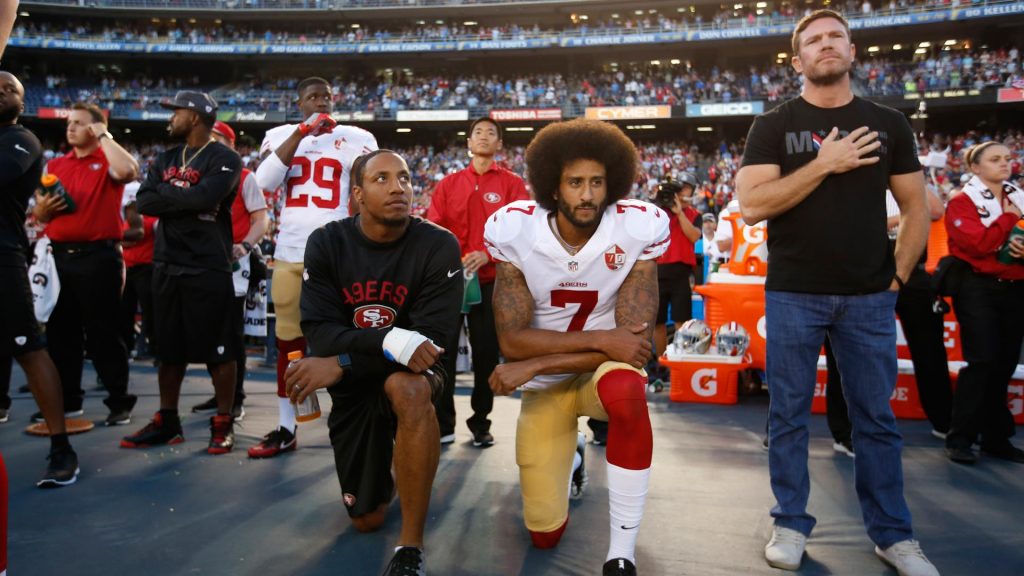 For many Americans, the sight of some NFL players purposely kneeling during the National Anthem is the ultimate symbol of this divide. One side sees young role models and leaders using their public platform to bravely protest government abuse—especially what they consider racially charged police violence. The other side feels hurt and confused by millionaire beneficiaries of the American Dream figuratively spitting on the American Flag and the sacrifice of dead and maimed military heroes.
For many Americans, the sight of some NFL players purposely kneeling during the National Anthem is the ultimate symbol of this divide. One side sees young role models and leaders using their public platform to bravely protest government abuse—especially what they consider racially charged police violence. The other side feels hurt and confused by millionaire beneficiaries of the American Dream figuratively spitting on the American Flag and the sacrifice of dead and maimed military heroes.
It’s difficult to even discuss this situation rationally in many venues due to the raw and heartfelt emotions of people on both sides of the Red-Blue cultural divide.
Sadly, many schools have also become places of great conflict. For example, a national uproar occurred when a middle school teacher assigned her students to write letters to political officials urging them to pass stronger gun control laws. Should teachers tell middle school children what sides to take on political issues? And assign them to engage in activism for one specific side? At what point does teaching become brainwashing? A father of one of the students, a policeman, refused to allow his child to do the assignment. The father deeply disagreed with the politics of the teacher, and many of the other parents disagreed with the politicization of middle school in general. In response to backlash, the teacher allowed students to skip the assignment without penalty, but didn’t suggest writing against stronger gun control if this more accurately aligned with the student’s views. The same week, an elementary student was expelled from school for drawing himself hunting during a “free art” assignment, and a high school teacher was fired for a lengthy history-class soliloquy describing current members of the military as “the lowest of the low” in our society. Red and Blue cultures passionately disagreed on how these events should be handled. Both sides largely see the other’s view as ridiculous and extreme.
Another moment that epitomizes this division occurred on Broadway when the cast of Hamilton stopped the musical midstream to lecture the new Vice President elect, Mike Pence. Hamilton itself is an artistic icon—an American Les Miserables that underscores how the struggles of Washington, Jefferson, Hamilton and their families and peers unleashed freedom in a way that has now spread to people of all backgrounds. The lecture itself was seen by one side as a welcome comeuppance to a dangerous new administration, and by the other as yet another gauche elitist attack against the will of the voters and the American system.
Networks, Numbers, and New Divides
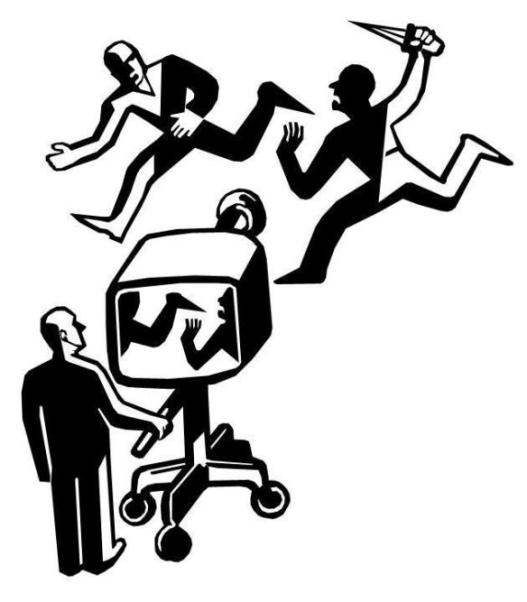 Thankfully this war is largely cultural—it has not devolved into massive physical violence between the two sides of a nation (like the French Revolution, U.S. Civil War, or Russian Revolution, etc.). Hopefully it will always remain peaceful. But in the fight for hearts, there is no doubt that a major civil war for the future of our republic is already under way.
Thankfully this war is largely cultural—it has not devolved into massive physical violence between the two sides of a nation (like the French Revolution, U.S. Civil War, or Russian Revolution, etc.). Hopefully it will always remain peaceful. But in the fight for hearts, there is no doubt that a major civil war for the future of our republic is already under way.
Worse, it is doubtful that any real solution is imminent. When one part of the nation generally believes most of what airs on CNN, ABC, NBC and MSNBC, while another part tends to place more trust in Fox News, Rush Limbaugh, or Trump tweets, the two aren’t going see eye-to-eye on much of anything. And when these two groups are the largest political blocs in our republic, we’re going to have genuine and repeated disagreements.
Perhaps the epicenter of this battle for “the hearts and minds of the people” is found in the media. And this poses a major challenge. Why? Because most of modern media—from both the Left and Right—has three serious problems:
1-It is largely agenda driven (“Forget the facts, full speed ahead!”)
2-It is shallow.
3-It is electronic.
Most people realize the problems with item #1. As a result, they stop listening to media outlets that are clearly against their views—and seem hostile to anyone with a different perspective. This has created another significant problem with modern media:
4-It is isolated. The Right listens to the Right, while the Left listens to the Left. Few listen to both. Few listen to the other side. Over time, media outlets increasingly cater to their narrow audiences, so the extremism increases.
Result: the divisions in our nation are getting wider, deeper, and more susceptible to anger and, too often, extremism and unhealthy thinking and actions.
The Missing Depth
 The 2nd and 3rd problems listed just above are equally dangerous. Many people are very busy—work, family, more work, community, more family. Little time is left over for meaningful civic involvement, much less for taking the time to really dig into each day’s news, truly understand what is happening, and go way beyond the 30 second sound bites or even 3 minute segments on any given story. An hour of the news is more than most can spare—and most hour newscasts only provide a very shallow overview of a few of the day’s news topics. In short, shallow. No time for depth.
The 2nd and 3rd problems listed just above are equally dangerous. Many people are very busy—work, family, more work, community, more family. Little time is left over for meaningful civic involvement, much less for taking the time to really dig into each day’s news, truly understand what is happening, and go way beyond the 30 second sound bites or even 3 minute segments on any given story. An hour of the news is more than most can spare—and most hour newscasts only provide a very shallow overview of a few of the day’s news topics. In short, shallow. No time for depth.
The result is that nearly all shows repeat a few top stories, with only a bit of detail. Even if a person watched television all day, he or she would usually only hear about the same top stories, addressed shallowly over and over—with different opinions but nothing really weighty or reflective. Depth is almost unheard of in most of today’s media.
This is especially true of the electronic media. Besides, television, radio, and online media typically interact with human brains more like entertainment than like something really, truly important. When we watch or listen or surf our news, in most cases, we are in the mode of moving quickly from one thought to the next. Even if we try to focus, ads, pop-ups and crawlers invade our screen with multiple headlines and distractions all at once. Our devices were purposely designed this way, in fact.
Reading the news, in contrast, naturally moves the focus into our intellect. A good start. “But nobody wants to read anything longer than a page…” today’s editors assure everyone. Many editors put the limit at “two paragraphs.” If we don’t read more deeply, we’ll truly and literally become a nation of sheep. Deep thinking is needed to deal with the reality of today’s complex and globally-interconnected world—for any citizen. And deep thinking about the news is basically impossible unless we’re reading (or listening/watching to a source that takes) much more than 5 minutes to really address an issue in some depth.
The Jefferson-Madison Debates
The term “fake news” means the following to most people: news that pushes a false agenda, distracts from truth, lies. But “shallow news” is just as bad for the nation. Even “accurate news” that is shallow is a major blow to our society. And this accounts for most of what media consumers experience. When it is both fake and shallow, we’re in real trouble.
The Left and Right argue about which news reports are “fake,” but few even claim to offer real depth in their news. And even fewer consumers seem to be actively searching for and embracing deeper news.
To reiterate: the Red-Blue divisions are growing, and intensifying, and this means that major problems are ahead unless we do something about it. My plan is to write a weekly (or, sometimes, every two week) article that treats real topics in enough depth to help readers take a step back from the constant screaming of electronic news, and really understand a topic (one at a time) enough to see behind the scenes of modern media spin and fake/shallow posturing.
 More will, of course, be needed to stop our seeming national sprint toward more civil conflict. But I know this weekly column will make a difference—for those who read it.
More will, of course, be needed to stop our seeming national sprint toward more civil conflict. But I know this weekly column will make a difference—for those who read it.
It was the reading and thinking about articles and pamphlets during the American Founding generation that helped America gain freedom, and deep thinking is vitally needed today. I’m calling this new series of weekly articles The Jefferson-Madison Debates, and I hope you’ll join us.
It’s going to be fun.
— Oliver DeMille
(RSS Feed sign up here ***)
Category : Aristocracy &Arts &Blog &Business &Citizenship &Community &Constitution &Culture &Current Events &Economics &Education &Entrepreneurship &Generations &Government &History &Independents &Information Age &Leadership &Liberty &Mission &Politics &Producers &Prosperity &Statesmanship &Technology
The Jefferson-Madison Debates: Are Today’s Education and Politics Entering the Age of Star Trek?
May 12th, 2018 // 9:02 am @ Oliver DeMille
“A shoe, too, is no longer a finished product, but an endless process of reimagining our extended feet, perhaps with disposable covers, sandals that morph as you walk, treads that shift, or floors that act as shoes.” —Kevin Kelly
“We have long argued that as the Web extends in usage…increased access to factual information would improve the quality of public discourse. However, the opposite seems to be occurring.” —Don and Alex Tapscott
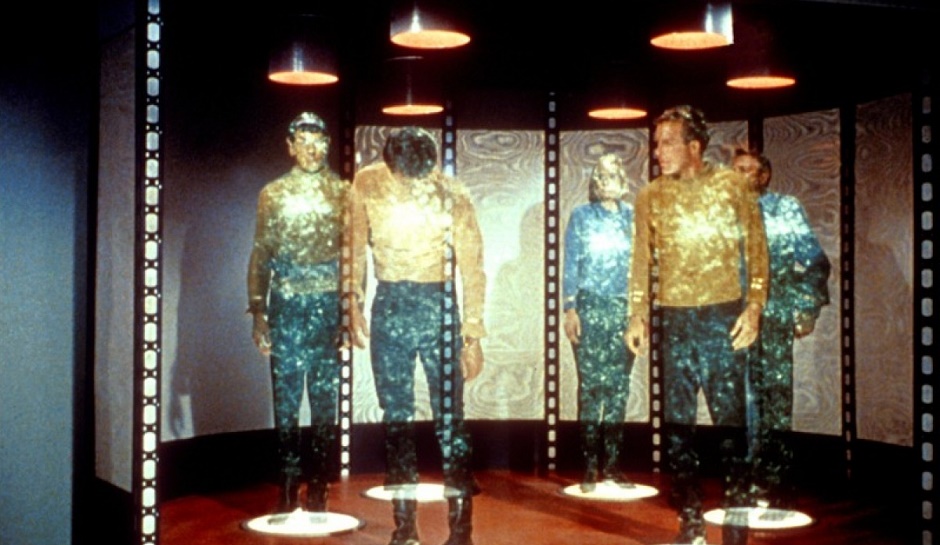 Given how much technology has changed the world in the past twenty years, and how differently we now live, it’s easy to assume that the Internet Revolution has brought the big change—and this era of massive shifts will slowly relax back into some kind of normality. But the truth is that we are just at the very beginning stages of the Information Age. The changes have just begun.
Given how much technology has changed the world in the past twenty years, and how differently we now live, it’s easy to assume that the Internet Revolution has brought the big change—and this era of massive shifts will slowly relax back into some kind of normality. But the truth is that we are just at the very beginning stages of the Information Age. The changes have just begun.
Following are a few of the major developments still ahead, as described by the experts on current technologies. As you think about each of these, consider the ramifications of these trends as they relate to the future of education, career, the economy, and the type of education needed for the emerging economy:
1. Autonomous vehicles. Self-driving cars are a reality.[i] How long they will co-exist with human drivers before the laws require all cars to be driven electronically remains to be seen.[ii] Self-driving planes, boats, and trucks will also change our lives drastically. Flying vehicles are next. As drone technology improves, taking people as passengers may not be too far away.
2. 3D Printing (additive manufacturing).[iii] This will revolutionize transportation, shipping, and manufacturing. Things that can be printed out in our own homes don’t need to be built in factories, or shipped by truck, airplane, or even drone. 3D printing will also have significant impact in medicine by printing certain medical implants.[iv] In fact, 3D printers now print food, including candy—and some people think it even tastes good.[v] One taste tester wrote: “It tastes like an after-dinner mint mixed with a sugar cube.”[vi]
3. 4D Printing. The printers will print smartobjects that are self-learning, and self-altering in response to their environment.[vii]
4. New Smart Materials. As Klaus Schwab, Founder of the World Economic Forum, put it: Some are “self-healing, self-cleaning, metals with memory that revert to their original shapes, chemicals and crystals that turn pressure into energy, and so on…. Take advanced nanomaterials [nano means smaller than the human eye can see] such as graphene, which is about 200-times stronger than steel, a million times thinner than a human hair, and an efficient conductor of heat and electricity. When graphene becomes price competitive…it could significantly disrupt the manufacturing and infrastructure industries.”[viii]
5. iMoneyCenter. As Forbes put it: “Your cellphone will become a global bank. Mobile money accounts already outnumber traditional bank accounts in parts of the developing world, and new technology will turbocharge that trend, allowing payments to anyone, anywhere, in local currencies.”[ix]
6. RFID (Radio Frequency Identification). Tiny tags can be put on pretty much anything, or anyone, and track where it is at any time, all over the world.[x] This technology is cheap and easy to use. The tags can even contain sensors that keep track of how well the item is doing, and what it is doing.[xi]
New Normal
Kevin Kelly said of the various kinds of small digital devices that are being created: “A few are shrinking to the size of the period following this sentence. These macroscopic measurers can be inserted into watches, clothes, spectacles, or phones, or inexpensively dispersed in rooms, cars, offices, and public spaces.[xii] Sensors can be built to watch and listen.” He also wrote: “Massive tracking and total surveillance are here to stay.”[xiii]
The machines are becoming ubiquitous.[xiv] Moreover, a lot of people like it this way. One report summarized the trend as “Our Love-Hate Affair With AI.”[xv]
The ramifications of the new era of machines for freedom and relationships of all kinds are immense.[xvi]
7. Gene Mapping and Synthetic Biology. This is popularly called the creation of “Designer Babies.” “It will provide us with the ability to customize organisms by writing DNA.”[xvii] “Today, a genome can be sequenced in a few hours for less than a thousand dollars.”[xviii] And at some point scientists foresee artificial memory implanting into peoples’ brains.[xix] Just download what you want to know—facts, dates, formulas, etc. Gene Mapping will impact agriculture and the energy sector (by producing biofuels) as well as medicine and education.[xx]
8. Personalized Medications. Medicine, from those used to treat advanced diseases to simple aspirin, will be personalized for each individual—“tailored to your DNA.”[xxi] These will likely be very expensive at first, further widening the gap between the upper and other classes.
9. Non-Communicative Relationships. A number of popular magazines each month present articles that tell men and women they need to turn off their electronic gadgets and talk to their spouse or significant other. The articles are detailed and specific, with advice like “look your spouse in the eye while you talk to her,” and “actually listen to the words he says and try to connect with his logic and feelings,” etc.
The volume of such articles suggests that this is a serious problem. Relationships are often victims of addiction to electronic devices, texts, messages, and other incoming communication that is more highly valued than interaction with the live person in the same room.
Relationships and Roboticships
Moreover, emerging technology will very likely throw a serious monkey-wrench into many relationships. VR (Virtual Reality[xxii]) is incredibly advanced now, and will soon be on the market in extensive ways. A person can slip on a VR helmet or glasses and be transported mentally to a whole new world. Some VR research and development is focused on porn, although the tech world prefers the term “alternative relationships.” How will this impact marriage, family, education, and stable relationships?
Robotics have reached the point that lifelike “partner dolls,” sometimes called “sex dolls”, that talk and interact are already available.[xxiii] Soon, experts say, they’ll be easily accessible online and sold in our corner neighborhood stores.[xxiv] It’s a potential revolution in lifestyles, and the impact on relationships will certainly be real.[xxv] It is unclear how this will influence marriage and family, but the prospects seem quite negative.
A number of apps try to fulfill the same need—for relationships in an electronic format.[xxvi] If we find it difficult now to put down our phones or take off our headphones to engage in meaningful conversation and relationships, imagine how difficult it will be to turn off the robots, apps, and VR glasses.[xxvii] VR, and lifelike personal relationship robots, can be programmed (or told by the user) to never argue, nag, disagree, shout, or storm away.[xxviii] Again, such devices won’t take the place of quality, mature relationships, but they could very well hurt or make such relationships more difficult.[xxix]
10. The Rise of the Algorithms. Online technology now employs numerous advanced algorithms and AI technologies that are learning to do everything from sensing where our eyes are gazing (in order to know our interests and sell to us)[xxx] to what our politics are (as mentioned above, this could be to allow providers like Facebook and Google, or others, to determine what news feeds to send us—to promote their own political goals), to how empty the milk carton in our fridge is (in order to order a fresh one).
Schwab said: “Amazon and Netflix already possess algorithms that predict which films and books we may wish to watch and read. Dating and job placement sites suggest partners and jobs—in our neighborhood or anywhere in the world—that their systems [algorithms] figure might suit us best.
The Man AI in Charge
“What do we do? Trust the advice provided by an algorithm or that offered by family, friends, or colleagues? Would we consult an AI-driven robot doctor with a near perfect diagnosis success rate—or stick with the human physician with the assuring bedside manner we have known for years?”[xxxi]
AI is tasked with watching us and learning from us, and as AIs become smarter, some of them will be incredibly effective forecasters. Companies may even be valued based on their AI. For example, Kelly wrote: “Amazon’s greatest asset is not its Prime delivery service but the many millions of reader reviews it has accumulated over the decades.”[xxxii] These reviews, and the AI that runs them, learns from them, and uses them to help predict what books each user is likely to enjoy, is a huge asset.
The concept of establishing corporate boards of directors made up entirely of Artificial Intelligence is discussed openly and seriously.[xxxiii] Do we want algorithms in charge of everything?
In education, the possibilities are seemingly endless—and just as alarming. Kelly wrote: “The tiny camera eyes that now stare back at us from any screen can be trained with additional skills…researchers at MIT have taught the eyes in our machines to detect human emotions. As we watch the screen, the screen is watching us, where we look, and how we react.
“Since this perception is in real time, the smart software [algorithms] can adapt what I’m viewing. Say I am reading a book and my frown shows I’ve stumbled on a certain word; the text could expand a definition.”[xxxiv]
This means that the text of the book is changing before you read it, based on what you have read so far and how you reacted. In other words, the computer is in effect censoring what you read before you even read it.
What about the author’s intent? Well, that depends. The AI, or the people who commission and oversee the AI, may decide to carefully protect the original text, or they may not. They may edit, censor, distract, etc.—whatever they think best achieves their goals.
Remember that thing called Thinking?
They may even have different ways of dealing with different people—like Google gaming the search system so that people who look up a certain Republican candidate get the most negative articles about him on the first page, while those who search for his Democratic opponent get the most flattering articles (or vice versa).
Or they might simply guide your searches to the companies who paid them the most to do so. If these guides are personalized and targeted to each individual user (like in the movie Minority Report), different readers will literally be getting a very different education. One student will read very different things than a second student, while the third reads yet another thing—all determined by AI and/or those who program and control the AI.
Kelly continued: “Or, if it realizes I am reading the same passage, it could supply an annotation for that passage. Similarly, if it knows I am bored by a scene in a video, it could jump ahead or speed up the action.”[xxxv] If we choose such functions on a menu, that’s one thing. But what happens if the big businesses or the cyber-governmental-industrial-complex just decides that this kind of censorship is best for the people? Or for a certain group or type of people, such as those from a certain religion or political party?
On purely educational grounds, having the computer supply definitions, commentaries and links is bad for thinking. It teaches rote dependence on experts, even if the expert is an AI. If we don’t have to question, ponder, or debate the books we read, we’ll be thinking a lot less. The words censorship and brainwashing aren’t farfetched in this context.
What about politics? The media and party-media machines already spread a lot of false information. What will happen when algorithms take over the media spin? It will personalize to each reader, each person using the Internet (or whatever kind of Supernet or Skynet takes its place). As such, the AI will learn how to confuse each person the most effectively. Again, this isn’t far from the personalized billboards and ads in the movie Minority Report.
(Un)Locked Doors
On an even larger scale, if an algorithm claims to predict which of various candidates would make the best president, prime minister, judge or senator, do we just give up voting altogether? After all, the voters seldom put in leaders who truly deliver what they promised. Or will the experts try to convince us that an algorithm-based AI should be our president and Congress and Court and make our top government decisions—getting rid of human error altogether?
And in all this, let’s not forget that someone can access the algorithms. All computers can be hacked—so far. As author Marc Goodman put it: “There’s never been a computer system that’s proven unhackable.”[xxxvi] Bigger technologies mean bigger hacks, with more drastic impact on people.
And won’t the growth of the Internet just funnel more and more power to a few elites who control the algorithms? The answer is “Yes. Emphatically yes!”
In fact, is there any way to stop this from happening?
11. “Reshoring.” This means that when high tech processes like 3D printing, gene mapping, and RFID tagging become mainstream around the world, many industrial jobs will be lost—but a lot of high-tech jobs will move back to the most advanced nations in search of highly-trained workers with expertise in areas conducive to high tech.[xxxvii] Whether this will happen or not remains to be seen. It may not happen at all. “…many workers [may]…end up permanently unemployed, like horses unable to adjust to the invention of the tractors.”[xxxviii]
12. Portfolio Careers. These occur where a person’s career includes doing several different jobs for different employers in the same day.[xxxix] For example, one person might be a teacher during the school day, a restaurant manager during the evenings, and an eBay seller in his spare time—all to make ends meet. Portfolio careers may become very widespread in the new economy. A lot of people probably won’t like such a development, leading to increased class divisions and conflicts.[xl]
13. Even Greater Class Divide. As Schwab wrote: “…half of all assets around the world are now controlled by the richest 1% of the global population, while the lower half” of the population control less than 1% of world assets.[xli] Or as the Tapscotts put it: “…the global 1 percent owns half of the world’s wealth while 3.5 billion people earn fewer than 2 dollars a day.”[xlii]
To be continued next week …
[i] Schwab, 15, 147-148; see also Kevin Kelly, The Inevitable, 2016, 50-51; Brynjolfsson, 14-20; See Sam Smith, “The Truth About the Future of Cars,” Esquire, April 2016, 69-74; Erin Griffith, “Disconnected,” Fortune, August 1, 2016, 44.
[ii] See Smith, 69-74.
[iii] Scwhab, 15; see also Brynjolfsson, 36-37; Kelly, 53.
[iv] Schwab, 15, 22, 161-167.
[v] Andrea Smith, “Print Your Candy and Eat it Too,” Popular Science, January 2015, 24.
[vi] Ibid.
[vii] Schwab, 16.
[viii] Ibid., 17.
Category : Aristocracy &Blog &Citizenship &Community &Constitution &Culture &Current Events &Economics &Education &Entrepreneurship &Foreign Affairs &Generations &Government &History &Independents &Information Age &Leadership &Liberty &Mission &Politics &Postmodernism &Producers &Prosperity &Science &Technology

